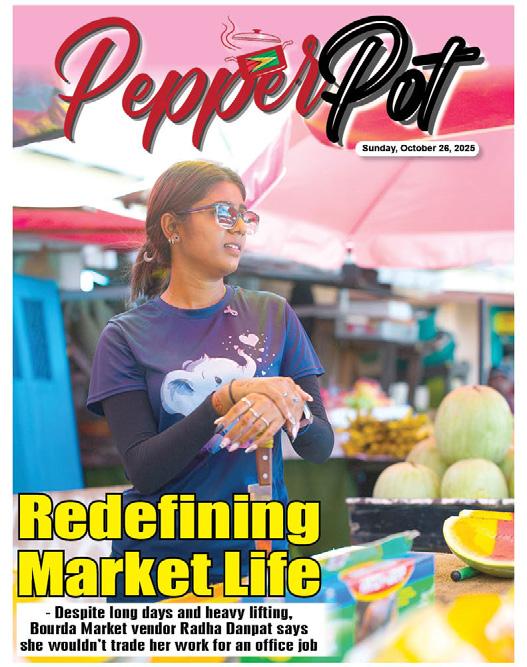



$14.8B invested to construct 6,000 house lots in East Berbice
Work begins on $4.3B Parika Port

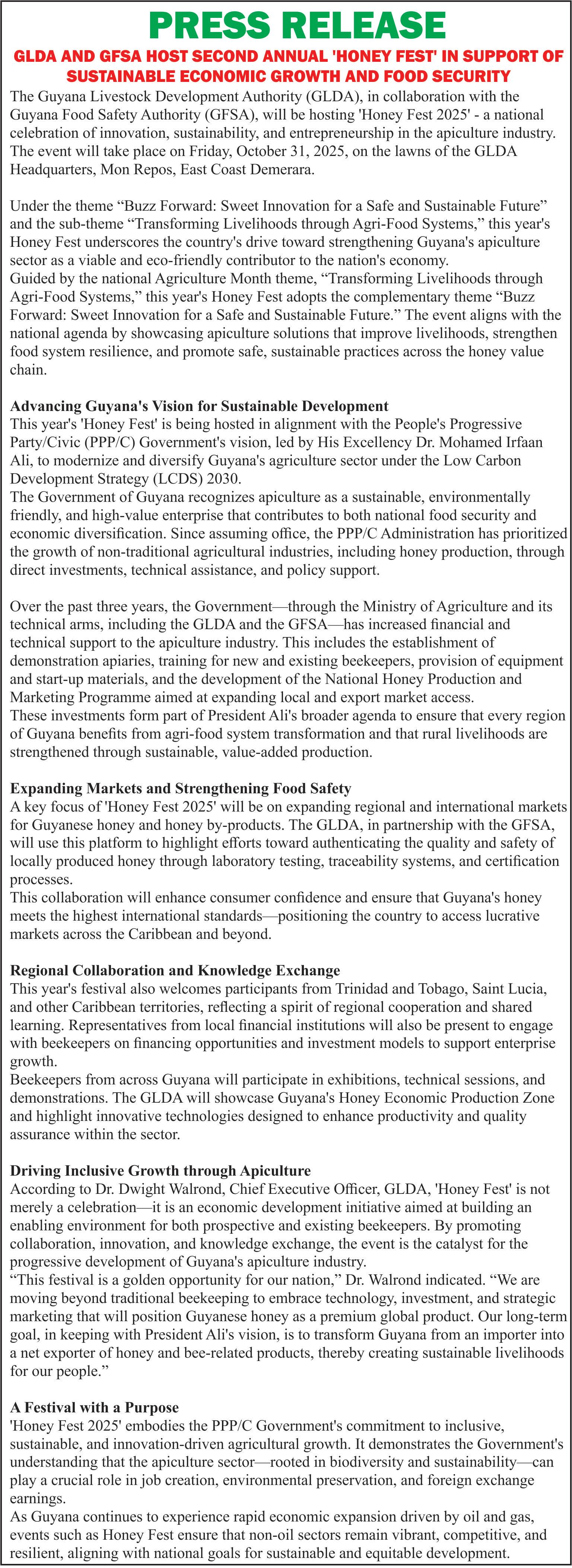







$14.8B invested to construct 6,000 house lots in East Berbice
Work begins on $4.3B Parika Port




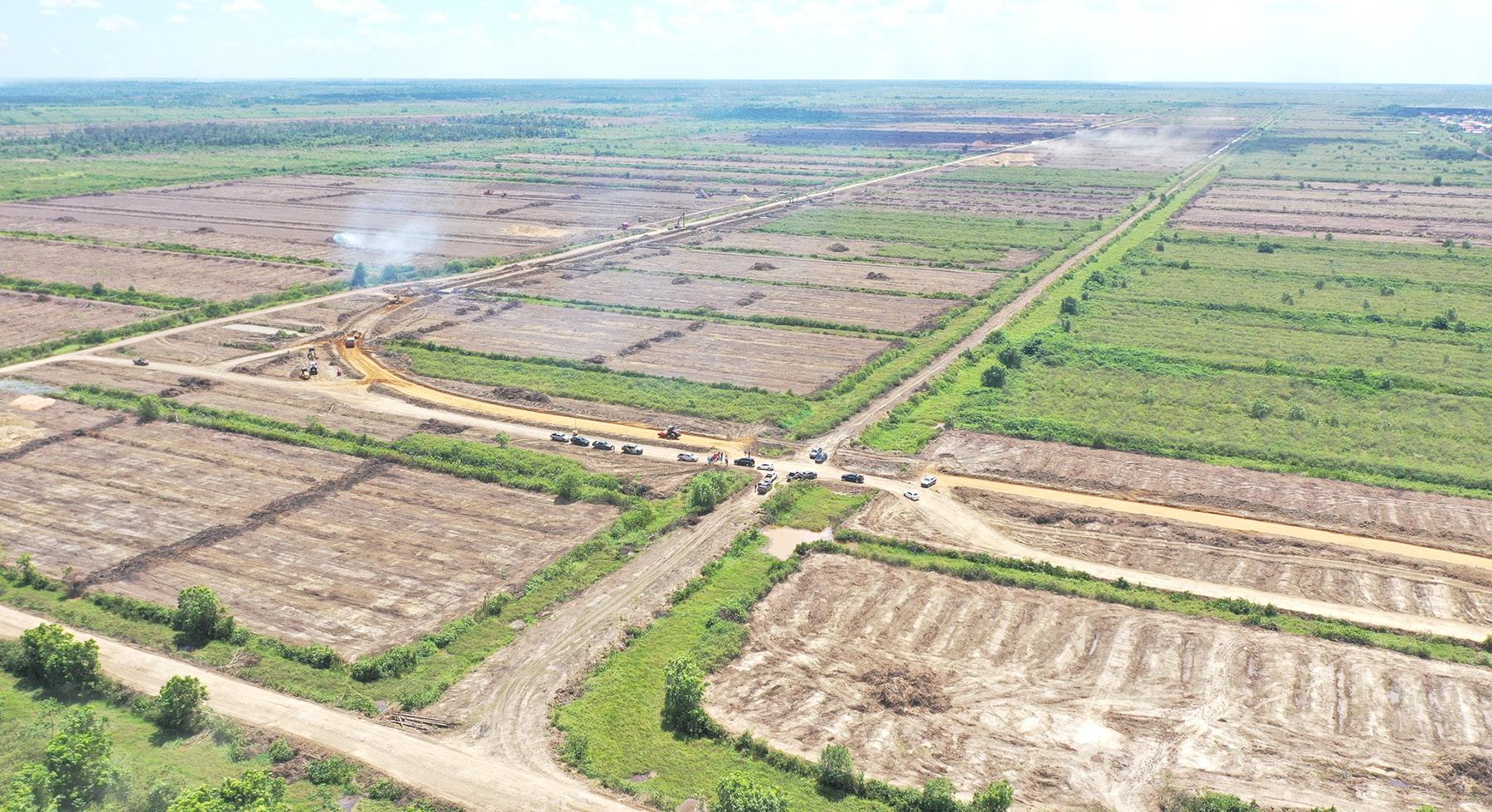
AS the government accelerates access to housing, $14.8 billion is being injected in infrastructure at Providence, Glasgow and Overwinning on the East Bank of Berbice, Region Six (East Berbice-Corentyne), according to Minister of Housing, Collin Croal, who noted that that will support the first phase of works to prepare nearly 6,000 house lots for beneficiaries, who were allocated land earlier this year.
According to a press release published by the ministry, the work, which includes land clearing, road and drainage networks, has been divided into 25 lots, each awarded to various contractors.
“The commencement date is in this very October, and we're looking for completion by the end of May for all of those beneficiaries to be able to have access or to see their lot,” Minister Croal said, during a visit to one of the sites on Friday.
The Housing Minister used his visit to assess the progress and reinforce the importance of ensuring deadlines are met.
Minister Croal also stated that favourable weather conditions are supporting the contractors’ progress, allowing for greater expediency. Key elements, such as main access roads, are being prioritised to manage the heavy-duty vehicles during the development.
Minister Croal also addressed
the government’s long-term vision for the housing sector, noting that a portion of the developed land will be set aside for future demand.
"All the lots have not been allocated.
We still have available lots, and some of this is going to be reserved
for future housing programmes," he said.
Also, on the ground were the Regional Chairman, Junior
Bassant; Central Housing and Planning Authority’s (CH&PA)- Regional Housing Officer, Diyaiyyih Dwarka and engineers.
Minister of Housing, Collin Croal, and other officials examine a map of the area
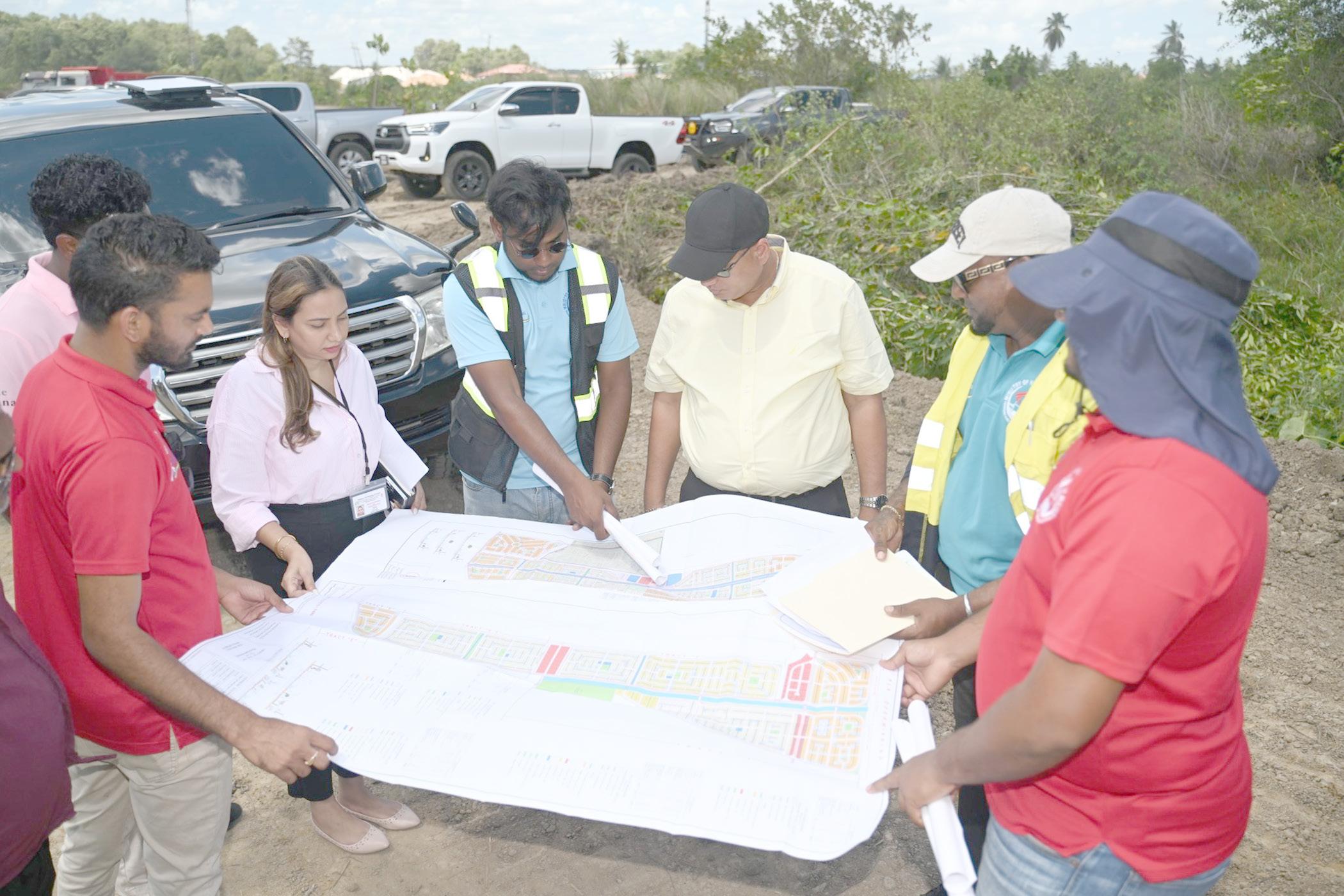
By Trina Williams
GUYANA’S investments in cancer care are reshaping how patients are diagnosed and treated, as the country is now expanding access with the incorporation of new technologies and improved screening capabilities.
These were the views expressed by the Director of Outreach at the Cancer Institute of Guyana, Dr Syed Ghazi, during a recent airing of the ‘Starting Point’ podcast.
Dr. Ghazi, one of the early pioneers of oncology services in the country, spoke extensively about Guyana’s transformation in the cancer treatment landscape and the progress that has been made.
From a single radiation unit to plans for a national oncology hospital, Dr. Ghazi noted that the advancements in cancer care not only reflect medical progress but also a growing national will to ensure no one faces cancer
without access to care.
While speaking on those early years, he highlighted challenges such as patients being in denial and refusing to be treated and the institute only offering limited services.
Today, the transformation is striking and Dr. Ghazi has labelled it as a “big change.”
From having “nothing there,” as Dr. Ghazi put it, Guyana’s Cancer Institute itself has gone through a number of phases: to offering CT scans, mammograms and X-rays.
“Now, I don't see that many advanced, neglected cases as we used to see. So that is itself a proof of progress we have made,” he said, while pointing to the awareness being raised.
Soon, Guyana’s Cancer Institute will offer brachytherapy, he disclosed.
“It's very effective for cervical cancer. Actually, it cures cervical cancer. In a meeting months ago with the President [President Irfaan

Ali), I found him also very interested.
He's passionate about treating those patients who are suffering. I think they're working on an oncology hospital. So, it is going to be a good milestone soon, when we would have not one, but maybe multiple institutions trying to treat cancer patients,” the director explained.
The government is working with Mount Sinai Hospital to establish an advanced oncology centre in Guyana, President Dr. Mohamed Irfaan Ali noted earlier this year, which will bring cutting-edge cancer diagnostics, treatment and research to these shores, thus reducing the need for patients to travel abroad for care.
With this, the health transformation also includes the establishment first-ofits-kind stroke rehabilitation centre in Guyana, designed to support one of the country’s leading causes of death and disability.
At the same time, the President had noted that Guyana is also building a first-class health emergency system, in collaboration with Northwell Health, to revolutionise emergency response and show faster, more efficient care and coordinated
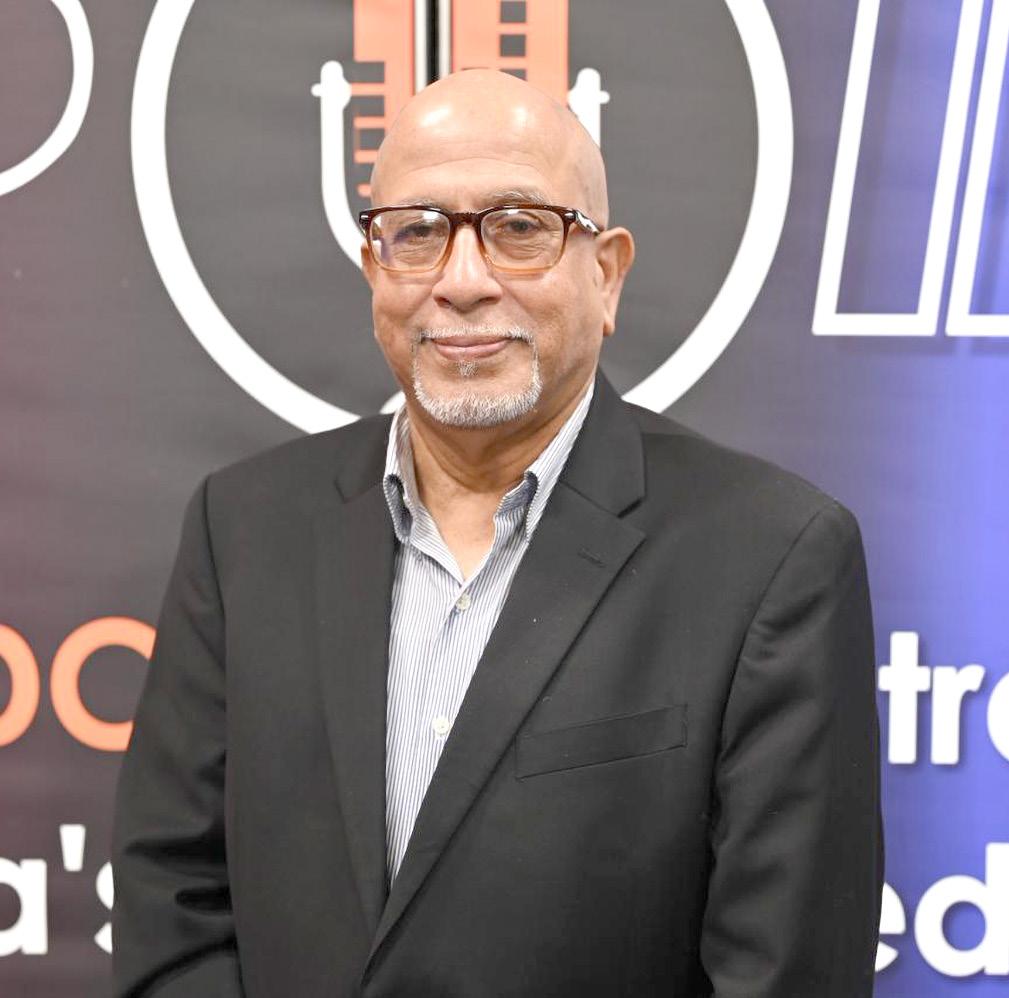
hospital transfer.
“We are not merely making improvements. We are building a system that is second to none, the healthcare system that is modern, responsive, compassionate and world-class,” the President had said.
Health services in Guyana have dramatically improved in recent years, with various health institutes receiving significant boosts to better serve cancer patients.
A new $43 million mammogram machine was com-

had reported earlier this year, that over 30 private hospitals, clinics, and health service providers signed Memoranda of Understanding (MOUs) with the Ministry of Health to provide services for the rollout of the Government’s various healthcare grants.
The signing took place in the Ministry of Health’s boardroom for these persons to provide services under the eye testing and spectacles voucher, cervical cancer screening, and the universal health voucher.
Some 31 companies are expected to provide services for eye testing and spectacles, eight for cervical cancer screening, and 36 for universal health screening.
missioned in April of this year at Lethem Regional Hospital in Region Nine, reducing the need for women in the hinterland to travel to Georgetown for breast cancer screening.
The Siemens machine is described as one of the most advanced systems globally, offering high-depth resolution and diagnostic precision. Takutu-Upper Essequibo became the first hinterland region to offer mammography services.
A year ago, mammography services were available only at the Georgetown Public Hospital Corporation (GPHC).
Breast cancer screening has since expanded, with mammography machines now in place at Suddie Hospital in Region Two, New Amsterdam Hospital in Region Six, and Linden Hospital Complex in Region Ten.
The Sunday Chronicle
In early February, Minister of Health, Dr. Frank Anthony, had said that all accredited medical laboratories across the country would be involved as the government moves to roll out the new universal healthcare voucher.
The initiative aims to provide 500,000 individuals with access to essential laboratory tests.
Set to launch soon, the programme will offer a $10,000 universal healthcare voucher to every Guyanese.
The eye testing and spectacles programme, which continues this year, was launched in June 2024 by the Ministry of Health, and was aimed at supporting Guyanese citizens by providing eye tests, screenings, and assistance with spectacles, if necessary.
Similarly, the cervical cancer screening programme was also launched in June 2024, and is set to continue this year, a move that was part of a comprehensive plan for the elimination of cervical cancer.

FORMER Chairman of the People’s National Congress/ Reform (PNC/R), Shurwayne Holder, who also served as a parliamentarian from 2020-2025, has accused party leader Aubrey Norton of excluding the Central Executive Committee (CEC) and unilaterally handpicking the incoming parliamentary lineup.
Holder’s comments directly contradict those of Norton, who, on Friday last, told a news conference that the party decided on the parliamentary lineup.
“The party chose the persons and, in the party, we give clear rationale,” Norton told reporters, adding: “We discussed with the people in the party. There’s a clear rationale for what was done and it’s the party’s decision and we are happy that we made the decisions we made.”
On reading Norton’s comments, Holder told the Sunday Chronicle that while he has no issue with the new parliamentary slate, he is concerned about Norton acting on his own while telling the general public otherwise.
Holder completely disagreed with Norton’s comments and contended that it has become “a norm” for Norton to unilaterally make party decisions, and it is among the reasons he tendered his resignation in September.
The former parliamentarian explained: “The core leadership of the party, as far as I know, was not involved in the
decision-making process.”
According to Holder, in his capacity as chairman, he wrote to Norton on September 6 after learning that Norton was making decisions regarding the selection for parliament, explaining that he should not make such
of the names recommended to Norton for Parliament was veteran executive member, Mervyn Williams; when the new parliamentary slate was announced and Williams was not on it, he resigned from the party in September.
“I thought that he should
matters, and I know he can also carry several other areas. And my thought process to it was that you only have 12 seats, and therefore you had to put persons that had the ability to cover multiple areas, because you don't have 31 seats or 32 seats to
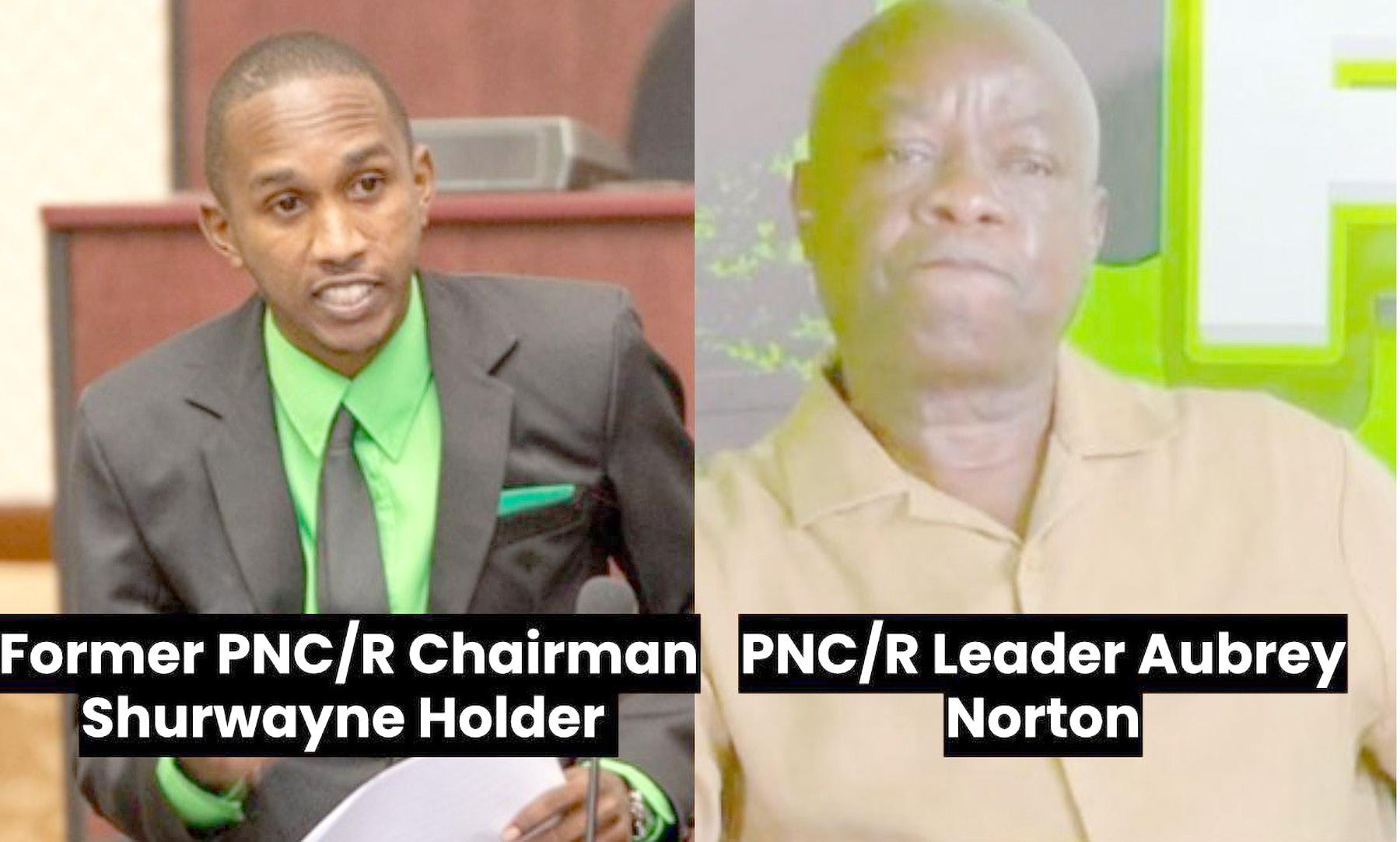
decisions in isolation.
“As far as I know, there was no decision. At least there was no CC [central committee], there was no central exec, because central exec meetings are called by the party chairman in consultation with the general secretary, who is his [Norton] rep,” Holder related.
The former party chairman alleged that some of the suggestions that were floated by other members of the executive to Norton were completely ignored.
According to Holder, one

have been selected because he's about the only person that can go deep into indigenous issues. He has lots of knowledge of indigenous
cover the various ministries,” Holder said, explaining that it would have been a wise choice to “at least” consider persons who had vast knowl-

edge to handle several ministries.
However, Norton “totally ignored” the note and Holder said, “as far as I know, he made the decision on his own.”
According to Holder, “I am fully aware that the CEC was briefed of his rationale after the fact, only a few weeks ago, maybe about two weeks ago, you had the first CEC, and they were told about the decision and why, rather than being a part of that decision. How it's normally done, is that your core group discuss, you might have a draft and you carry it to CEC for ratification, given your explanations, your rationale. That was not done.”
Holder was puzzled as to why Norton would brand his act as a party decision, given that even the procedural requirements were bypassed.
While the party constitution permits the leader to make decisions, Holder contended that no executive member would accept the unilateral selection of parliamentarians and allow for
someone to pen it as a “party decision.”
“At least I was party chairman. I was not at any meeting where that was discussed, I was not invited to any meeting where that was discussed, and I was fully aware that he was making those decisions on his own. I beg to differ with what he said,” Holder said.
Since he acceded to the Leader of the PNC/R and APNU in 2020, Norton has come in for severe criticism for his leadership style, which resulted in several heavyweights resigning from the party.
And for the first time in recent history, the PNC/R is no longer the main opposition party in the country, as it suffered a blistering defeat at the September polls, only gaining 12 seats in the National Assembly. The PNC/R has now been relegated to a weak third force as the We Invest in Nationhood (WIN) party is likely to take on the role as the Leader of the Opposition.



THE ongoing construction of the $4.3 billion International Parika Port marks more than just another infrastructural upgrade, it signals Guyana’s deliberate stride toward modernisation, connectivity, and economic diversification.
For too long, the Parika Stelling has stood as a vital but outdated artery linking Georgetown to the Essequibo and beyond. With the development of a state-of-the-art port facility, that artery is being transformed into a thriving hub for regional trade and international travel.
This project, now well underway, is emblematic of the kind of forward-thinking investments that
can propel Guyana into its next phase of economic growth.
The port will not only accommodate cargo vessels and cruise liners but will also enhance the efficiency of exports and stimulate tourism, two critical sectors that must work hand-in-hand for sustainable development.
Public Works Minister Bishop Juan Edghill’s insistence on continuous, well-coordinated construction work — “no closure without activity,” as he aptly put it — reflects the urgency and discipline needed to see such transformative projects through.
His commitment to stakeholder engagement, from farmers to boat operators, also underscores
a people-centered approach to progress. Infrastructure, after all, is only as successful as its integration with the communities it serves.The planned phases of the project, including the introduction of a luxury marina, restaurants, and entertainment spaces along the waterfront, promise to redefine Parika’s image — from a busy transit point to a destination in itself.
This aligns perfectly with Guyana’s growing ambitions to attract high-value tourism and showcase the natural splendor of the Essequibo region.
Yet, ambition alone is not enough. For the Parika Port to truly deliver on its potential, me-
ticulous execution, transparency, and long-term maintenance must remain non-negotiable.
The involvement of multiple contractors — Gaico Construction, Toolsie Persaud Limited, and A&S General Contractors — demands strong oversight to ensure quality, safety, and timeliness.
Similarly, the relocation of residents and speedboat operators must be handled with empathy and fairness, ensuring that progress does not come at the expense of livelihoods.
The Parika Port’s success will not only be measured by its physical completion but by its ability to catalyse broader economic linkages, from facilitating smoother
exports of Guyanese goods to positioning the country as a maritime gateway to the Caribbean.
Coupled with other major national projects, such as the Gas-to-Energy initiative and the Vreed-en-Hoop Shorebase, this new port strengthens Guyana’s foundation for inclusive, diversified growth.
In essence, the Parika Port project embodies what development should look like in the modern era — purposeful, people-focused, and forward-looking. If managed wisely, it will stand as a testament to how Guyana can translate its resources and vision into tangible, lasting prosperity.
Dear Editor,
I HAD absolutely no intention of diverting public attention to a group of retired seniors associated with an entity called the Oil and Gas Governance Network (OGGN).
But it is painful having to read this sort of nonsensical analysis almost every day in the mainstream media, where they are given endless space to propagate a series of catastrophically flawed interpretations of Guyana’s oil and gas fiscal outcomes.
My response is specifically to address their recent critique of a

statement made by ExxonMobil Guyana’s Country Manager, who correctly asserted that the company remains in a negative position on its investment in Guyana. OGGN took issue with this claim and sought to disprove it by pointing to the reported profits of the oil companies.
The analytical flaw lies in the failure to contextualise the argument within the comprehensive investment commitments undertaken by the oil companies in the Stabroek Block and the economic fundamentals underpinning the project. A robust analysis must incorporate these dimensions to
accurately assess the viability and implications of the sector.
Towards this end, the total committed investment in the Guyana market—specifically in the Stabroek Block, which to date contains proven reserves of approximately 11 billion barrels of crude oil—amounts to about US $65 billion.
As of 2024, the book value of the oil companies’ asset base in the Stabroek Block stands at US $34 billion, representing roughly 52 per cent of the total committed investment.
This means that the consortium still has US $31 billion in
additional investment yet to be realised on future projects within the Block, based on the proven reserves.
Consequently, from a financial standpoint, the companies are still in a net negative position of approximately US$31 billion, or 48 per cent of total committed investment. It is that simple.
Conclusion
When OGGN focuses narrowly on reported profits without understanding the broader investment and capital recovery structure, it produces analyses that are not merely incomplete—they are
misleading.
The oil companies’ balance sheet position must be viewed through the lens of total project economics, where cumulative investment, capital depreciation, and future development obligations define profitability. Until the total committed investment is recovered and returns are realised beyond that threshold, the assertion that the consortium remains in a negative position is not only correct but financially irrefutable.
Sincerely, Joel Bhagwandin
THE prevailing explanation for the collapsed popularity of the Stabroek News and the Kaieteur News is that modern technology has caught up with mainstream newspapers and social media, and online news outlets have destroyed the power of the mainstream print and electronic media houses.
That is a valid theory, but one has to be careful how one applies that theory to Guyana. The sharp decline of the Stabroek News (SN) and Kaieteur News (KN) began before they became victims of the online age. What the online age has done is to hasten their demise.
Space will not allow for an elaboration of the withering away of KN, so that analysis will have to wait. In relation to SN, profound dialectical changes to the class structure of Guyana after Hoyte’s Economic Recovery Programme (ERP), which was continued by subsequent
PPP governments did not allow for the SN to sustain its existence since that existence was dependent on a resuscitation of the hegemony of the Portuguese mercantile class and the expansion of the Mulatto/Creole class (MCC).
The complex and profound social changes in Guyana between 1995 and 2010 cannot be outlined in a mere newspaper column of 800 words.
What follows below is an enormous compression of class analysis and could best be described as a few short notes. I apologise to readers for the extreme brevity.
In the book, “The Birth of the Stabroek News,” its co-founder, David DeCaires, declared that the essential reason for birthing SN was to rejuvenate the private sector.
DeCaires was using a euphemism; he meant the Portuguese petty bourgeoisie that was extensively decapitated through migration from 1968
onwards, and Burnham’s state socialism blueprint.
Because Guyana’s social structure was dormant, Hoyte’s ERP began to give impetus to a revitalisation of that social structure.
This opportunity was used by the SN co-founders, DeCaires and Fitzpatrick, to start the paper as a form of class rebirth. But it was impossible for SN to rekindle the Portuguese petty bourgeoisie because that class was extremely tiny.
The ERP ushered in profound class changes. This took the form of: the rebirth of the traditional petty bourgeoisie, mostly Indian families that stayed; the return from the diaspora of sections of that traditional petty bourgeoisie; the emergence of a nouveau riche class, which was neither traditional petty bourgeoisie nor the birth of a new petty bourgeoisie.
This was a new class consisting of genuine small en-

trepreneurs and people who dabbled in dubious business practices, which got them rich quickly. Also appearing on the scene was a rebirth of a more sophisticated lumpen proletariat with money to spend because of the drug trade.
Since the SN emerged at a time when the Guyanese society was still in the doldrums, the SN became a sensational superstar overnight. There was no private media, there were no private radio stations, and there was no television at all. The SN became coterminous with society. People simply clamoured for the return of the private newspapers, and since SN was the only one existing, the SN became the biggest thing in Guyana from 1986 onwards.
But the dialectical changes that led to the birth of the SN would also be responsible for its death. Class changes were taking place rapidly,
and those changes were not led by the Portuguese elites or the MCC. As the private sector expanded, as radio and television came on the scene, as KN emerged to compete with SN, and as authoritarian state behaviour began to wane, the superstardom of SN began to fade.
By the time DeCaires decided to retire from running the newspaper, it no longer commanded the importance and popularity it had from 1986 to about 2000. After his death, the DeCaires family showed no interest in the newspaper business and decided to migrate. The family still controlled the majority shares but had agreed that the editor-in-chief, Anand Persaud, will buy into the business.
Mr. Persaud, on his own, took the SN into an anti-PPP direction. That was where it was when online news outlets, podcasts and social media platforms overran both
it and the KN. The era that brought SN to life and made it the jewel of Guyana is gone forever.
Mr. Persaud is content to let it continue as an anti-government outlet because Mr. Persaud is frenetically anti-PPP. He is also an incompetent editor.
The DeCaires family has no interest in it, and now that the matriarch, Mrs. DeCaires is seriously ill, Guyana may soon see the end of a DeCaires presence in SN. As for its future, that is doubtful. All over the world, newspapers are being miniaturised. I doubt SN and KN will be around for another ten years. They are losing millions annually.
DISCLAIMER: The views and opinions expressed in this column are solely those of the author and do not necessarily reflect the official policy or position of the Guyana National Newspapers Limited.
YOUNG entrepreneurs will soon have an opportunity to turn their business ideas into reality, thanks to the fact that the government is working to set up a zero-interest development bank, according to Bounty Farm Ltd. Managing Director, David Fernandes.
Fernandes made these remarks during a recent episode of the ‘Starting Point’ podcast and urged young Guyanese to seize the opportunity and build strong financial reputations from day one.
“The fact that the government is speaking about the development bank for small entrepreneurs at 0 per cent interest gives them a real chance of succeeding. When the rates are so high, 15, 20 per cent interest, there’s no way that a small entrepreneur could actually reap the benefits of competing at the same time,

making money and try to pay the bank correctly. So, this is fantastic,” he said.
The Managing Director also urged them to identify where there are gaps in the marketplace and fill them, noting that: “adding value is critical, because adding
value, especially in non-perishable commodities, is critical.”
He also told young people that they could even mirror the success of local brands such as Umami and Beharry and build regionally recognised brands.
“There are many opportunities and I think that the next generation of Guyanese are the ones who are now kids and teenagers have a great, great opportunity at some special things in their life that we never had when I was growing up in the early 70s and the 80s,” he said.
Access to funding for young entrepreneurs, women, and small business owners in Guyana could soon become easier as the government is moving to set up the zero-interest development bank.
This was announced by Vice-President Dr. Bharrat Jagdeo during a recent press conference, where he explained that this bank will be designed to convert ideas into thriving businesses.
Speaking on the government’s vision, Dr. Jagdeo said the concept of a development bank was born out of years of surveys, consulta-
tions and conversations with citizens across the length and breadth of Guyana.
Dr. Jagdeo said: “Many started a business, but they can’t either grow the business or get the idea translated into a business because of the lack of financing… and we made it clear, we want to create an environment where young people, women and all Guyanese for that matter, can make use of the opportunities in Guyana to create income for themselves and their families and to hold their wealth.”
He said it was in that regard that the government believes that a good starting point would be to ensure that these companies have access to the capital. As the government forges ahead with this venture, Dr. Jagdeo said stakeholders are working on its development.
About US$200 million in seed funding will be used
Work on the concept has started, he said.
“We want an early budget next year where we will be putting part of the financing to start the bank in the budget,” he said, adding, “We hope that before the end of next year that this bank will be fully established and functional.”
The bank will advance credit for small businesses at zero interest with fewer collateral requirements. To hasten this commitment, an expert committee has been entrusted with formulating the model of the SME Development Bank.
They will need to study global experiences, delineate the legal and institutional framework, and identify the financial structures required to operationalise the bank.
LAST week, Opposition Leader Aubrey Norton surfaced and gave the media corps an alarming dose of his delusion about the just-concluded 2025 election, and the selection of PNC MPs for the 13th Parliament.
Norton said that there were certain developments which took place during the polls that his party did not anticipate or were not adequately prepared for. He said that there was a lot of money that went into the 2025 elections. He claimed that the other parties were bribing and inducing the voters in open violation of election rules. He even said that at Linden, one political party was buying bicycles and votes.
Norton blamed “rigging” for the PNC-led APNU's poor performance and loss of support in certain areas. The opposition leader said he was proud of the APNU’s team and the manifesto. He defended them right through the press conference.
Similarly, he did not feel obligated to give any explanation to the probing media for his decisions on MPs but insisted that he chose who met the criteria that were established. Norton said that Dr Terrence Campbell was
selected to lead APNU's team in the parliament and that he was a member of the party at the time of selection. He remained tight-lipped specifically about snubbing Christopher Jones, Shurwayne Holder and many others from being chosen to go to parliament.
In Norton’s world, he is now going to focus on building the PNC back and restoring the public’s confidence in his party. He said he was not for sale during the 2025 elections and has integrity.
Anyone who listens and watches the press conference will drown in a sea of laughter, surprise, and shock. Norton is delusional and may still be stuck on planet Mars if he thinks he is making political sense of his loss at the polls.
Maybe pride and his ego do not allow him to come to grips with reality. The truth is, Norton is being ‘a big crybaby’ whose parents should bring him a comforter. Maybe Norton should go back into hiding to grieve his loss. After all, people have the right to grieve, and some Guyanese grieve differently.
Some go into their mental faculties and make up the perfect scenario that justifies the loss that they experienced. Then, they in-
ternalise it before settling on why they lost and did not win. They truly believe the lie and fabrication.
This is a dramatic episode called a delusional disorder. It is a mental health illness and is a serious condition classified as a psychosis.
Firstly, Norton needs to withdraw from the limelight and seek out help if he is, in fact, suffering from a delusional disorder. Norton’s beliefs on the elections are not based in reality, and there is a treasure trove of evidence to the contrary. And what is serious about this delusion is that Norton lies with a straight face.
Here are the facts and the truth. Firstly, Norton’s rise to political power came at a time when the PNC needed someone to lead it and someone to comfort it after David Granger lost power in 2020 and was highly unpopular with the PNC grassroots base. Norton offered himself up and was reluctantly accepted. Reluctantly, because he had no prior leadership in senior decisions.
From day one, Norton was butting heads with the old PNC guards like Joseph Harmon, Amna Ally and other personalities in the party. He was to create unity and togetherness, but created


division and disunity instead. He flexed his political power and reshaped the opposition party, redefining Forbes Burnham’s legacy of trying to behave like a dictator and hiding behind the word democracy.
When resourceful party people left, he recruited other unknowns. In the PNC Congress last year, he bullied and foisted himself into the leadership and presidential posts.
He did the same in the APNU+AFC political Coalition, causing it to break. Norton got a desperate relic named David Hinds from the WPA to join him. Neither of them or Juretha Fernandes stood any chance against Mohamed Irfaan Ali.
And instead of heeding the thunderous warning, they went ahead and lost the elections, and badly. Now, instead of removing himself politically, he schemes to both control the PNC and APNU MPs through Terrence Campbell, who is his puppet. Campbell will be Norton’s undoing in the end because the PNC Congress and members do not support him.
Secondly, a lot of money went into the 2025 elections, but it was how it was presented to the public by Norton. It was a couple of reasons why so much money and effort went into the elec-
tions. The stakes were high for all the parties contesting, even the PNC-led APNU, which is $83 million poorer after Norton sold its Republic Bank shares during the elections to try and keep up.
Each party has made bribery and vote-buying allegations against the other, but one has faced the largess – WIN and Mohamed. But, even after WIN and the PPP courted all the Regions away from PNC, even Linden, Norton is still not saying anything bad or criticising Mohamed and WIN. He can’t actually say his name and comes to the public, in all his delusions and lies, with claims of rigging and unfairness.
He suddenly thinks of campaign financing laws and stricter election laws, but shied away from disclosing honestly how much his party spent, and how much financial resources came from Nazar and Azruddin Mohamed into either his or PNC coffers.
Anyway, if he was paid, it would only be by WIN cause the PPP/C knew from day one that they would beat Norton into a pulp. In any case, Norton believes that he lost because of money. Really? That is what he is doing? The public can see bouts of delusion!
Thirdly, Norton has proven to be the most po-
larising opposition figure since Hamilton Green and Forbes Burnham. Therefore, if an opposition politician does not want to tow his line, he will eliminate the offending politician. He is petty, grudgeful and wicked. Norton likes to settle scores, so snubbing Jones and Holder come naturally. It is the same for all of his political enemies.
Campbell and Dexter Todd will surely be at the mercy of Norton politics. They will feel the polarising temperature of opposition politics. Finally, Norton should continue to hide his face and spare the public the agony of having to see or listen to a press conference again.
The public deserves better, and Norton should prioritise his mental health. If he is not ‘delulu’, then he is a cunning man or con artiste. For the public, it is hard to watch the PNC implode and even harder to see its leader having bouts of delusion right in their face. They know the truth.
DISCLAIMER: The views and opinions expressed in this column are solely those of the author and do not necessarily reflect the official policy or position of the Guyana National Newspapers Limited.

MOST people use the terms “civic” and “civil” interchangeably; however, these concepts differ significantly, despite some areas of overlap. Understanding the distinction is essential to effectively chart a way forward for an important national initiative of President Irfaan Ali.
During the Diwali celebrations, President Ali called upon faith leaders in churches, mosques, and temples to join forces with the government in addressing social challenges like gambling, addiction and a marked decline in values and morality. He emphasised that economic transformation is limited without a solid ethical foundation.
To help guide the conversation and devise a robust plan of action, faith leaders must first embrace civil engagement as much as, if not more than, fulfilling their civic responsibilities. “Civic” comes from “Ci-vis” or “Civi-cus”, Latin terms that denote the role, duties and responsibilities of a “citizen” to one’s country. Participating in the electoral process, such as voting or even cam-
paigning, is a key aspect of civic responsibility. When there is low voter turnout, political pundits describe this as evidence of poor civic engagement.
In the lead-up to the September 1 vote, there was clear evidence that faith communities across the board were displaying some degree of civic engagement. I say ‘some’ because I have nothing to compare it with. A crucial question arises at this point: What happens when civic society fails to serve the citizens of a country? In other words, what happens when a government tramples upon the rights of its citizens and ignores their needs?
At this juncture, the role of civil society becomes critical. In authoritarian systems, the state systematically weakens or co-opts civil institutions, depriving them of agency and undermining their ability to act as a check on state authority. Wherever this has taken place in modern history, civil unrest, civil war, coups d’tats, or outright revolutions often occur.
In mature political economies, civil society usually
works alongside the state to achieve the common good. The common good is often defined as ‘convention’ or ‘tradition’, i.e. the norms and values that a majority of citizens hold in common.
Allow me to offer an example from the Classics. At the end of Homer’s Iliad, the warrior Achilles drags the dead body of Hector in the dust around the walls of the city until, finally, upon the command of Zeus, on payment of a large ransom, Achilles delivers the body for proper burial.
“Thus held they funeral for Hector, Tamer of Horses,” writes Homer. Tradition or convention, such as performing the proper rites of burial, prevails, and it stills the troubled hearts of the people of Troy. The unburied dead were an atrocity, a barbaric act, too much for them to fathom.
Likewise, when the state fails its citizens, as seen when unarmed Black men and women are killed by police in the United States, it becomes civil society’s duty to protest, but always within the bounds of order and reason and never to the point of anarchy.

Civil society, therefore, is an independent sphere where faith groups, in particular, can take creative and autonomous steps to inspire citizens to live purposeful lives. The state cannot teach people how to be happy.
What it can do is ensure that when you turn on the tap, there is clean water; when you switch on the light, there is electricity; that your children receive a proper education and, upon graduation, have access to decent jobs; and that when they grow old or fall ill, doctors and wellequipped hospitals are there to care for them.
The state cannot make people decent human beings. It cannot legislate courtesy, empathy, generosity, or forgiveness; these qualities come from civil society. President Ali grasps this fundamental truth. He recognises that his government can build roads and bridges, but it can’t put a police officer at every corner to enforce speed limits. It can arrest and prosecute men who abuse their wives, but it can’t stop a conflict before it starts.
No government passes a

law requiring us to feed the poor or shelter the homeless, yet when we fail to do so, society as a whole bears the consequences.
No state by-law obliges us to treat our neighbours with courtesy, yet we do, and this is precisely why a vibrant civil society is indispensable.
The state can legislate against hate speech, but it lacks the moral reach of a Pastor, an Imam, or a Pandit to awaken love and compassion for strangers in our hearts.
If we truly want to root out domestic abuse, bullying, cybercrime, and addictions to alcohol or gambling, civil society, especially faith groups and their leaders, must move beyond preaching. They must teach, from an early age, the virtues of courtesy, respect, empathy, and mercy.
President Ali recognises that while his administration can open the doors of prosperity, it cannot fulfil the deeper role of civil society. The state can inspire ambition, but it cannot teach people how to withstand disappointment or despair when life does not go their way.
As President Ali reminded the nation over the Diwali holidays, when civil society performs its role effectively, everything else begins to work better: education, the economy, public safety, and ultimately, democracy itself.
DISCLAIMER: The views and opinions expressed in this column are solely those of the author and do not necessarily reflect the official policy or position of the Guyana National Newspapers Limited.

GUYANA’S oil sector continues to make history. With production now surpassing 700,000 barrels per day (bpd), and the country on course to reach 900,000 bpd by the end of 2025, Guyana has firmly established itself among the world’s fastest-growing oil producers.
This milestone, powered by ExxonMobil Guyana and its partners Hess and CNOOC, reflects more than industrial progress; it signals the emergence of Guyana as a serious energy player with growing global influence.
But this achievement is not only about output. Each increase in production translates into higher national revenues, which in turn fund the country’s broader devel-
opment ambitions.
The government’s strategy has been clear: use oil income to expand infrastructure, strengthen education and healthcare, and lower the cost of living.
We are already seeing the results; the new Bharrat Jagdeo Demerara River Bridge is helping to improve connectivity across regions, the gas-to-energy project is advancing with the promise of cutting electricity costs by half, and the World Trade Centre Georgetown has opened its doors for Guyanese businesses to reach international markets.
These are the kinds of investments that will turn the oil resource wealth into long-term national progress.
A growing industry also
requires a skilled local workforce. Over the past few years, Guyana has made significant strides in preparing its people to take advantage of opportunities in the oiland-gas sector and its many supporting industries.
The Guyana Technical Training College Inc. (GTTCI), has launched advanced diploma programmes to prepare technicians for the field, while TVET and STEM initiatives are expanding practical training across the country. Importantly, much of this learning is now taking place locally rather than abroad, a sign that Guyana is building institutional capacity and retaining expertise.
This national focus on capacity building is being strengthened through collab-

oration.
The partnerships between government and companies such as ExxonMobil Guyana, SBM Offshore, MODEC, and others are not confined to production platforms; they extend across logistics, health and safety, IT, hospitality, and other services. Each of these sectors is benefitting from a “locals first” approach, ensuring that oil wealth is linked directly to Guyanese talent and enterprise.
Of course, none of this progress can come at the expense of environmental responsibility. Companies are expected to meet strict standards set by the Environmental Protection Agency, and many have gone beyond compliance to introduce new
technologies and systems.
The Fast4Ward design for Floating Production, Storage, and Offloading (FPSO) vessels, for instance, aims to significantly reduce emissions from offshore operations.
Meanwhile, continued environmental surveys help monitor and protect Guyana’s rich coastal ecosystems.
These efforts demonstrate that it is possible to pursue growth while maintaining a clear commitment to sustainability.
Oil may have opened the door, but it is strategic management and foresight that will determine how far the country goes.
What we are witnessing is the shaping of a new national identity, one grounded in opportunity, knowledge, and resilience. Guyana’s oil sector is not just fuelling the economy; it is driving the transformation of a nation ready to define its own future.
DISCLAIMER: The views and opinions expressed in this column are solely those of the author and do not necessarily reflect the official policy or position of the Guyana National Newspapers Limited.
The numbers tell one story: 700,000 barrels today, 900,000 tomorrow, but the real story is how Guyana uses this momentum. Every new project, every training initiative, and every investment adds to a foundation that can support generations to come.
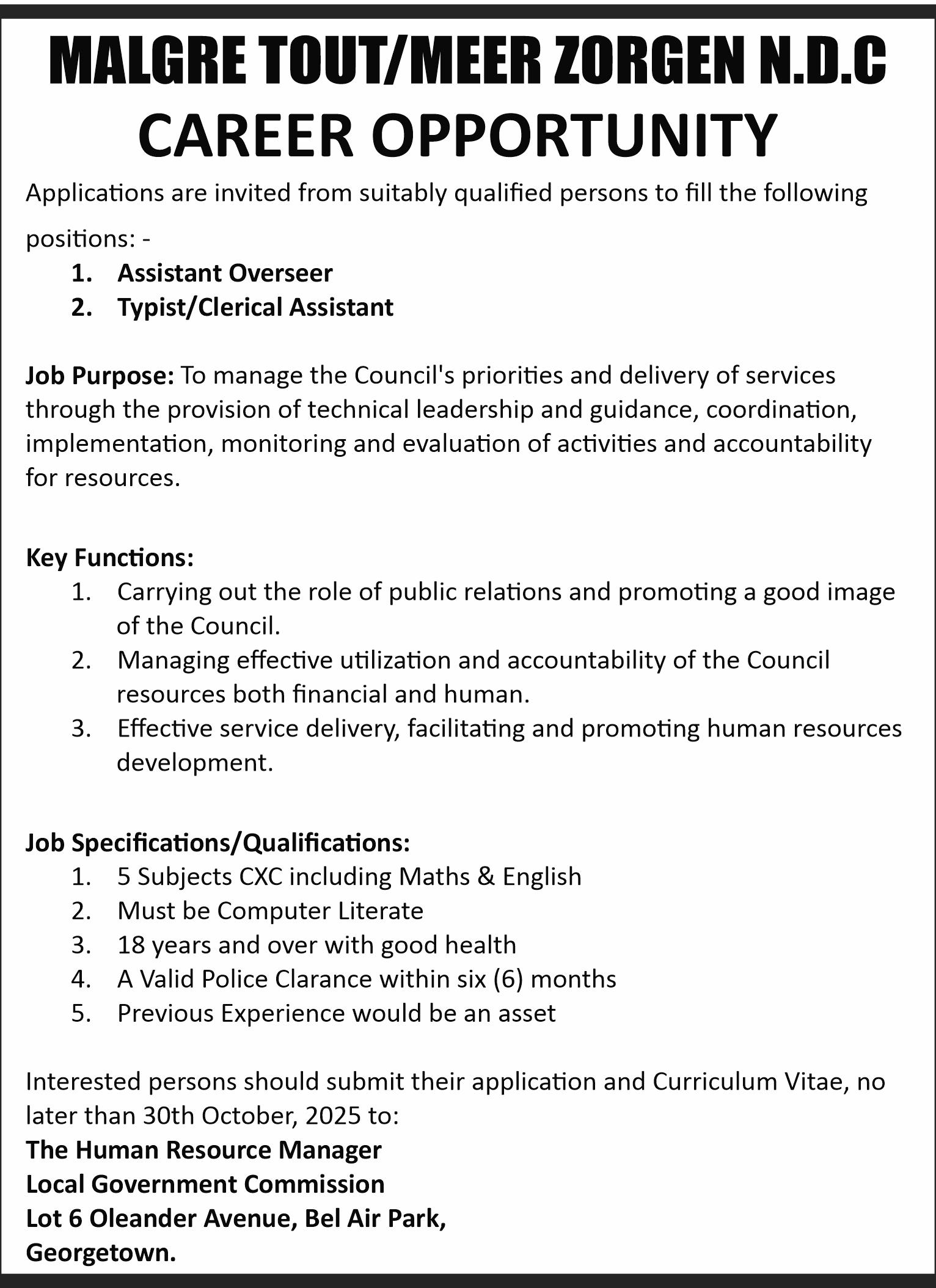
AS the oil and gas sector continues to transform Guyana’s economy, opportunities are reaching more citizens than before, as President of ExxonMobil Guyana, Alistair Routledge, has revealed that about 1,800 Guyanese are working offshore.
The oil boss made these remarks during a preview of today’s of ‘Starting Point’ as he explained that growing the Guyanese workforce is “one of our top priorities.”
Routledge stated that the natural resources of the country are to benefit as many Guyanese as possible, not just through the revenues they generate, but also through the people who gain employment or have business opportunities.
“Overall, about 70 per cent of the oil and gas workforce in the country is Guyanese. When we look at the offshore workforce that you were asking about, there are around 1,800 Guyanese that are employed working offshore,” he said.

Recently, President Dr. Irfaan Ali announced plans for Guyana to build its capacity in trading crude oil through strategic partnerships that will see the country boosting its expertise through knowledge and skills sharing.
In September, ExxonMobil Guyana started production at Yellowtail, the fourth oil development in Guyana’s offshore Stabroek block.
Yellowtail’s One Guyana floating production storage and offloading (FPSO) vessel joins the Destiny, Unity, and Prosperity FPSOs, bringing total installed capacity in Guyana to above 900,000 barrels of oil per day.
“Yellowtail’s ahead-ofschedule startup is a significant milestone for ExxonMobil and the people of Guyana,” said Dan Ammann,
President of ExxonMobil Upstream Company. “With Guyanese making up more than 67 per cent of the country’s oil-and-gas workforce and over 2,000 local businesses engaged, this project reflects our deepening roots in the country and our shared commitment to long-term, inclusive growth.”
The One Guyana is the largest FPSO on the Stabroek
block to date, with an initial annual average production of 250,000 bpd and a storage capacity of two million barrels. Oil produced from the FPSO will be marketed as Golden Arrowhead crude.
By 2030, ExxonMobil Guyana expects to have a total production capacity of 1.7 million oil equivalent barrels per day from eight developments.
ExxonMobil Guyana’s deepwater developments are the most successful in the world. In five years, the company has started up four complex offshore mega-projects under budget and ahead of schedule – while simultaneously advancing plans for four additional projects by the end of the decade.
The oil major continues to deepen its commitment to local content and workforce development, investing heavily in Guyanese businesses, training, and industrial capacity.
Since beginning operations in 2015, ExxonMobil and its contractors have spent
over US$2.9 billion with local businesses. In the first half of 2025 alone, US$419 million (approximately GY$87 billion) was directed to 1,800 Guyanese vendors, demonstrating a strong focus on supporting local industry.
This year also marked a milestone with the launch of in-country fabrication at the Vreed-en-Hoop Shore Base Inc. (VEHSI), including the production of quad joints and Pipeline End Terminations (PLETs), a step that enhances Guyana’s industrial capabilities.
As of mid-2025, the company and its contractors employ more than 6,200 Guyanese, representing 70 per cent of the oiland-gas workforce. Women make up one-third of employees, and 1,800 Guyanese are working offshore. In addition, the workforce has received over 370,000 hours of training in leadership, technical skills, professional development, and health, safety, and security protocols.
THE lawns of the Ministry of Agriculture were transformed into a vibrant display of colour, culture, and culinary creativity on Friday, as staff gathered for the Ministry’s Annual Inter-Agency Cook-Off Competition. This year’s event was themed “Diwali-Inspired Cuisines,” encouraging teams to bring traditional Indian flavours and festive inspiration to their dishes.
Although Minister of Agriculture, Zulfikar Mustapha, did not deliver a formal address, he spent much of the afternoon interacting with staff and visiting the cooking stations, engaging in light-hearted conversations and sharing in the excitement of the event. His presence, according to participants, added to the sense of camaraderie and appreciation for the Ministry’s culture of togetherness.
Each participating agency was tasked with preparing one main dish, one side or dessert, and a non-alcoholic beverage. The challenge required dishes to embody the Diwali spirit, vegetarian, flavourful, and
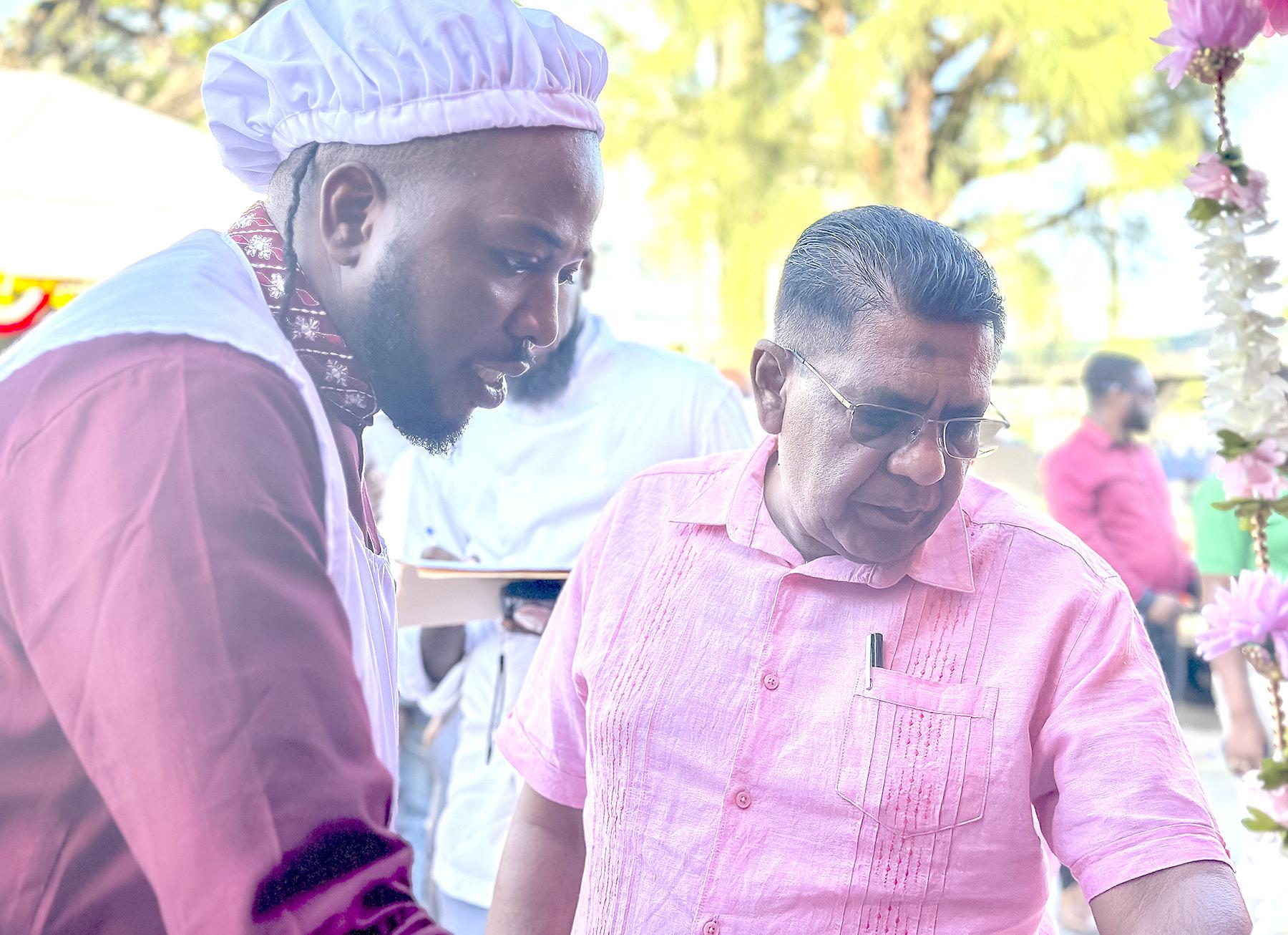
reflective of the festival’s traditional foods, while still allowing room for creative expression and cultural fusion. Judging began promptly at 15:00 hours, with renowned Chef, Kester Robinson and culinary professional, Omaiah
Hall, evaluating each entry. The dishes were scored across five categories: taste and flavour, presentation, originality, adherence to the Diwali theme, and team spirit or booth décor. The competition was close, with only a few
points separating the top contenders. The National Agricultural Research and Extension Institute (NAREI) emerged as the first-place winner with 180 points, edging out the Guyana Sugar Corporation (GuySuCo), which placed
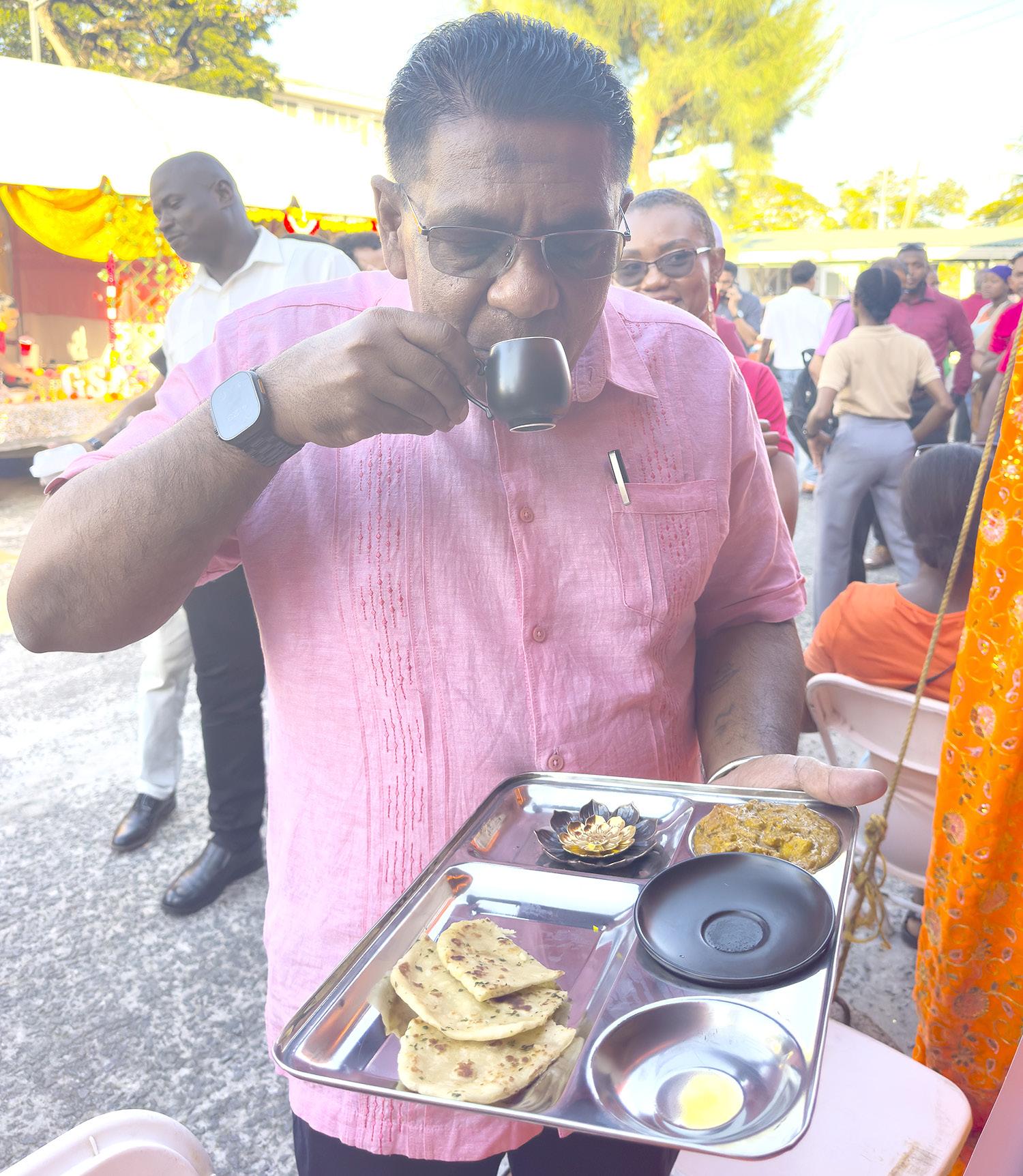
The Guyana Rice Development Board (GRDB) secured third place with 177 points. Winners’ tokens of appreciation were presented by the Minister and the Permanent Secretary.
For many participants, the event was more than just a friendly competition; it was an opportunity to celebrate the ministry’s diverse workforce and the cultural traditions that bring people together.
THE China-Guyana Joe Vieira Friendship Park, a landmark recreational development on the West Bank of Demerara, is now 83 per cent complete and remains on schedule for public opening in the first quarter of 2026.
This is according to Minister within the Ministry of Public Works, Madanlall Ramraj, who inspected the site on Friday. The US$12 million project, funded through a grant from the Government of China, is part of the government’s ongoing commitment to expand recreational spaces, promote healthy lifestyles, and provide safe, accessible areas for families, children, and youth to enjoy.
According to a press release issued by the Ministry of Public Works, Minister Ramraj noted that infrastructural development goes beyond roads and bridges.
“The investments by the government in national infrastructure are not just to build roads. National
infrastructure is about connecting people, and that’s what parks do.
“The conceptualisation of the park was to ensure that people have spaces to spend time with their families. Our citizens need spaces to have family time, our children need safe spaces to explore recreational activities, and we as a government are excited to see this project come to fruition,” Minister Ramraj was quoted as saying.
Designed to combine modern infrastructure with natural beauty, the China-Guyana Joe Vieira Friendship Park will feature a range of sporting and recreational amenities, including football, basketball, volleyball, table tennis, and lawn tennis facilities.
A dedicated children’s play area is already taking shape, while carefully planned green lawns and local tree species will preserve the park’s natural charm and provide a peaceful environment for visitors.
Accessibility and convenience

have been key considerations in the park’s development. Three main entrances will serve the site, and a new exit road at Schoonord, along with planned upgrades to surrounding roads, will improve traffic flow and make it easier for residents and visitors to reach the park safely.
Minister Ramraj highlighted the broader social and economic benefits of the park.
“This park will bring tremendous benefits to residents across Region Three,” Minister Ramraj added. He noted, “It will not only serve as a space for recreation and leisure, but also encourage healthier lifestyles, promote youth engagement through sports, and provide a safe, green environment for all families to enjoy.”
The park is part of a wider government effort to invest in infrastructure that serves the people directly, fostering not only physical connectivity but also social inclusion, economic growth, and

Minister Ramraj, accompanied by officials from the Protected Areas Commission, technical officers from the Ministry of Public Works, and project contractors, expressed satisfaction with the pace of construction (Ministry of Public Works photos)
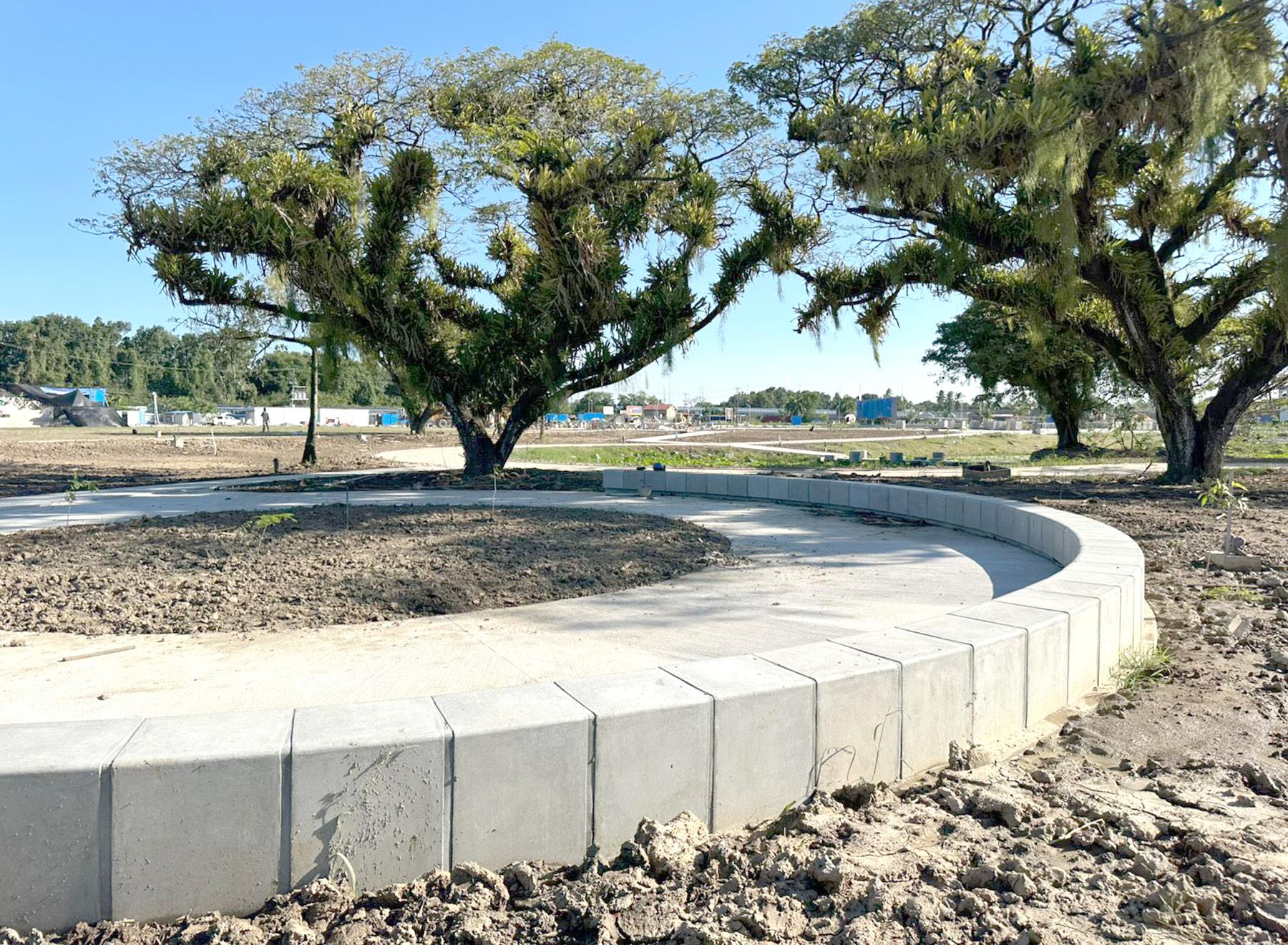
national unity. Minister Ramraj, accompanied by officials from the Protected Areas Commission, technical officers from the Ministry of Public Works, and project contractors, expressed satisfaction with the pace of construction.
He reaffirmed the government’s commitment to delivering quality, people-centred projects that enhance the lives of Guyanese and strengthen international co-operation. Once complete, the park is expected to become a major attraction in Region Three, drawing families, sports enthusiasts, and community groups to a modern, eco-friendly space designed for leisure and community engagement.
AN external investigation has been commissioned by the Ministry of Health into the death of baby Wendy Wharton, who passed away in the early morning hours of October 12, 2025 at the Diamond Regional Hospital on the East Bank of Demerara.
The ministry joined the hospital community in mourning this loss and reaffirms its commitment to a transparent and comprehensive review of the circumstances surrounding the incident.

A statement issued by the ministry read: “Immediately following the event, the hospital initiated an internal clinical investigation led by the attending medical officers, midwifery, and nursing teams. The review was conducted under the supervision of the Hospital Quality and Patient Safety Department, in keeping with the Ministry of Health’s established
standards for the reporting and assessment of critical incidents.”
The investigation confirmed that the infant was born at 38 weeks and 2 days gestation via spontaneous vaginal delivery on October 10, 2025. Apgar scores were
recorded at 9, 10, and 10, indicating healthy postnatal adaptation.
The infant remained clinically stable and was discharged in good condition on October 11, 2025, continuing to room-in with her mother, the Health Minister noted.
According to the statement, on October 12, 2025, at approximately 05:34 hours, the infant was discovered unresponsive.
Nursing and medical staff immediately commenced resuscitative efforts, including full advanced neonatal life support, in accordance with established protocols.
Oxygen was available and adequately supplied throughout the procedure,
the ministry reported.
During this period, the hospital experienced a brief power outage; however, the backup generator was activated immediately, and the ongoing resuscitation efforts were not affected in any way, the ministry noted.
Despite sustained and comprehensive intervention, the infant was pronounced deceased at 07:51 hours.
A post-mortem examination revealed evidence of bronchoaspiration of gastric contents (material from the stomach that was inhaled into the bronchi and lungs), which may have contributed to the infant’s sudden collapse, the statement read.
While the internal inves-
tigation has been completed, the Ministry of Health has also commissioned an external investigation to ensure an independent and thorough review of all clinical and procedural aspects related to this tragic event.
The statement further read: “The Ministry of Health, together with the Diamond Regional Hospital, remains steadfast in its commitment to continuous improvement of healthcare systems and protocols to ensure that all citizens receive the highest quality of care.
Our thoughts and heartfelt sympathies remain with the Wharton family during this profoundly difficult time.”
WORK on the first phase of the International Parika Port is progressing smoothly and will be heightened in the coming weeks as the project advances. The $4.5 billion port facility will facilitate international travel for cruise liners or cargo ships transporting produce to the Caribbean, and for persons seeking luxury travel.
Importantly, the new port will help modernise Guyana’s export process and significantly boost regional trade. Minister of Public Works, Juan Edghill, recently led an inspection alongside the General Manager of the Transport and Harbours Department (T&HD), Yolanda Hughes, and engineers overseeing the project to get a first-hand view of impending works.
He said that although work has begun on a minimal scale, it is time to increase the pace. One thing that will not be tolerated, he emphasised, is the closure of sections of the wharf without active work taking place.
“From the time that it is closed off, works have to be continuous. So, my instructions to the engineers are that the contractor is not to start until he has his materials, equipment, and everything on site,” he emphasised.
The public works minister explained that, in the first phase, Guyanese can expect extensive land reclamation and the implementation of new systems. Executing the first phase of works are contractors Gaico Construction, Toolsie Persaud Limited, and A&S General Contractors.
Before the project design was greenlighted, consultations were held with all stakeholders, including farmers, minibus drivers, taxi drivers, boat operators, and businesses, essentially all agencies that currently operate in the area.
The minister pledged that engagement will continue with stakeholders as works accelerate. Further, he stated that three major adjustments will have to be made. These include the relocation of speedboats that are often parked or left at the wharf for days. “That whole section will be developed, so the speedboats will have to move further back,” he said.
The wooden section that facilitates the operation of the MV Sabanto and Kanawan,
roll-on and roll-off ferries and other vessels will remain in place while works are ongoing. He said these adjustments will follow or mimic the construction processes undertaken during the Bartica Stelling project.
Lastly, the old dilapidated building will be demolished and replaced with a modern terminal featuring waiting areas, and offices for the Transport and Harbours Department, Police, Immigration, Customs, and CANU. In addition, Minister Edghill revealed that the Central Housing and Planning Authority (CH&PA) has already engaged residents living on the sea dam within the project’s alignment for relocation.
“In another year and six months or 18 months, people

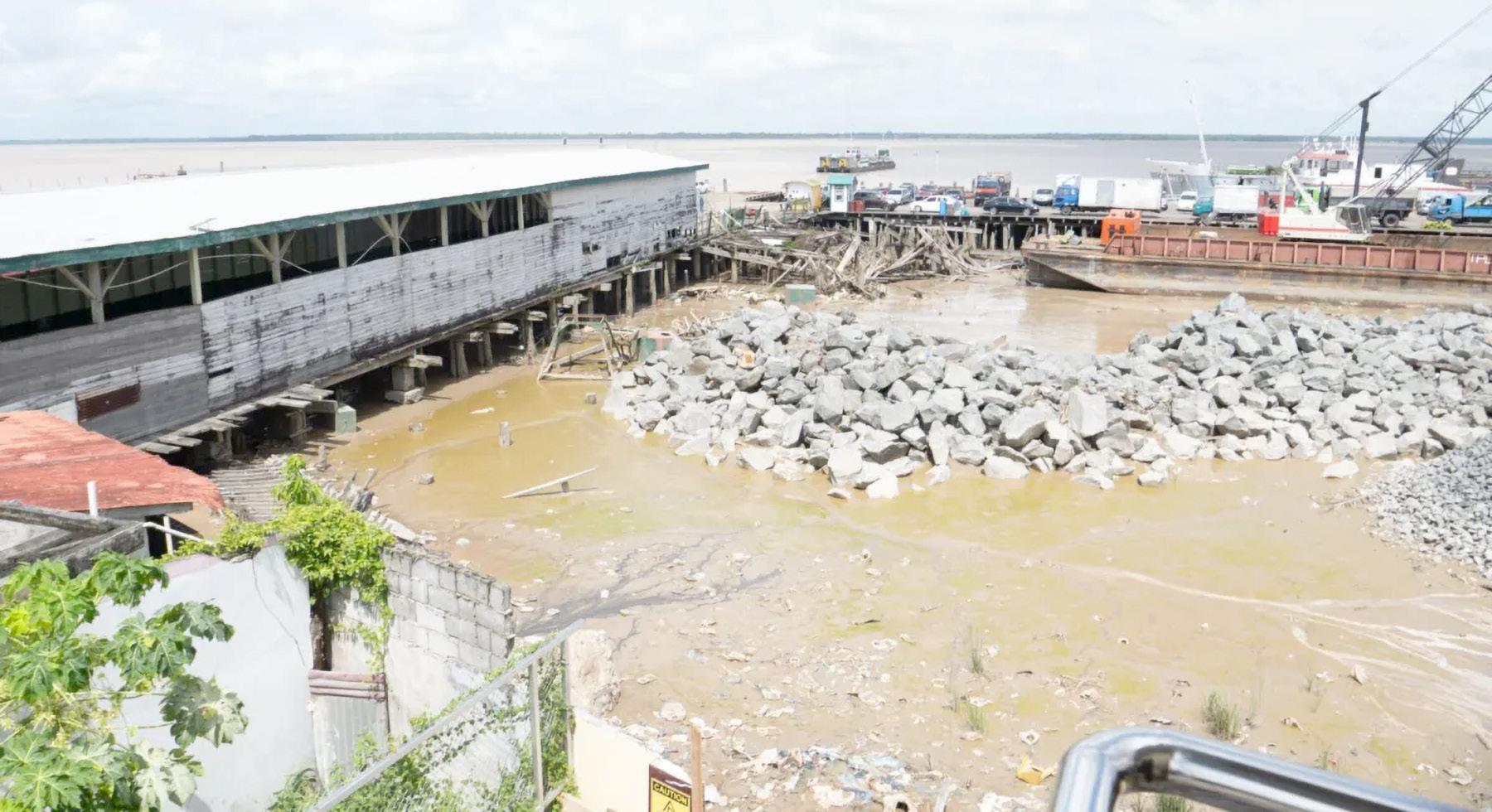
will be happy with what they are seeing out here at Parika, and that is phase one. And then we will come to you with phase two,” he said.
In phase two, a marina for yachts arriving from the Caribbean and elsewhere will be established. The entire waterfront will also be developed for entertainment and restaurants, providing tourists access to Essequibo’s rich, untapped beauty and biodiversity. “This whole area will come alive,” Minister Edghill stated ecstatically.
Moreover, this mega project complements other developments such as the transformative gas-to-energy project, Vreed-en-Hoop Shorebase, housing, road, drainage and irrigation infrastructure designed to bring immense opportunities for all Guyanese. (DPI)
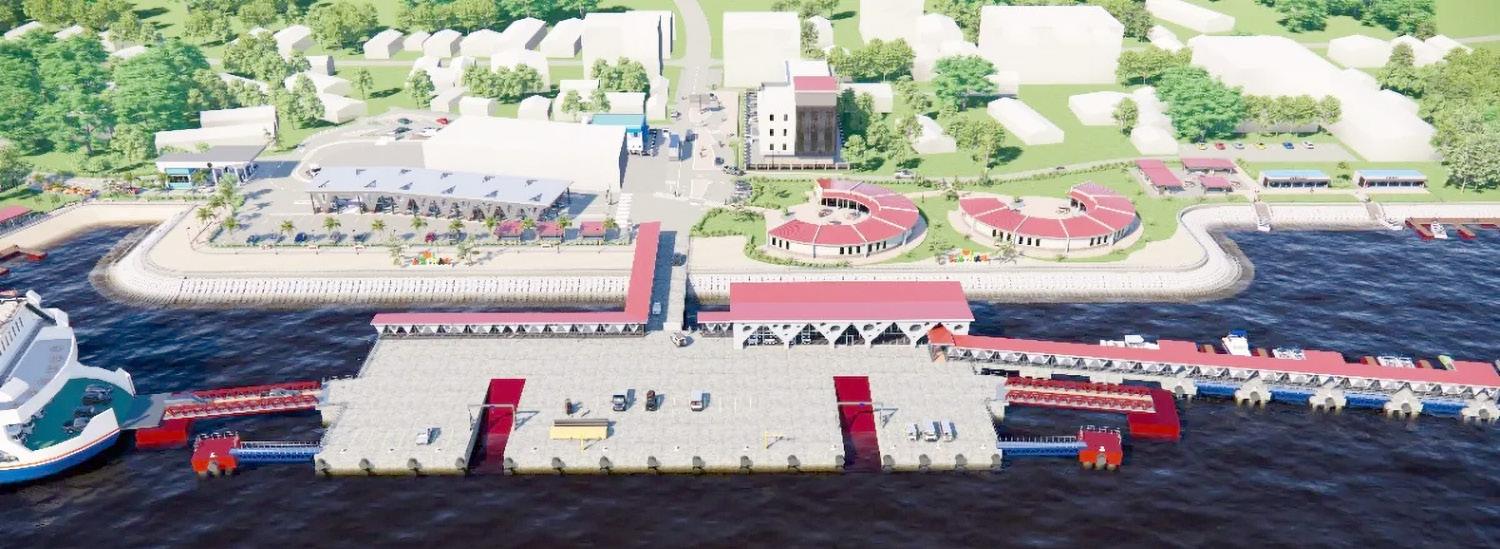
AS global trade rules grow increasingly complex and non-tariff barriers multiply, Caribbean economies like Guyana must modernise and strengthen regional co-operation to remain competitive.
This was the key message shared by trade experts during the World Trade Centre Georgetown’s (WTCG) seminar, titled “Successfully Navigating the Current Global Trade Environment,” held as part of the Centre’s inaugural Business Week activities.
Moderated by Ambassador Neville Totaram, the session explored how small economies can thrive amid tightening international trade conditions. Ambassador Totaram underscored that sustainable growth for developing economies hinges
on expanding exports and enhancing competitiveness.
“To grow, we must make other people’s markets ours,” he said. “Our businesses must be able to navigate the rules, the standards, and the financing systems that determine who truly gains access to global markets.”
He pointed to non-tariff measures—such as customs delays, certification requirements, and sanitary standards—as major obstacles that continue to frustrate exporters. “Predictability is what every trader needs,” Totaram added, stressing that the ability to comply efficiently is now as critical as product quality.
Adding practical insights, Abiola Heyliger, International Trade Policy Analyst and former U.S. Trade Negotiator, highlighted the adminis-
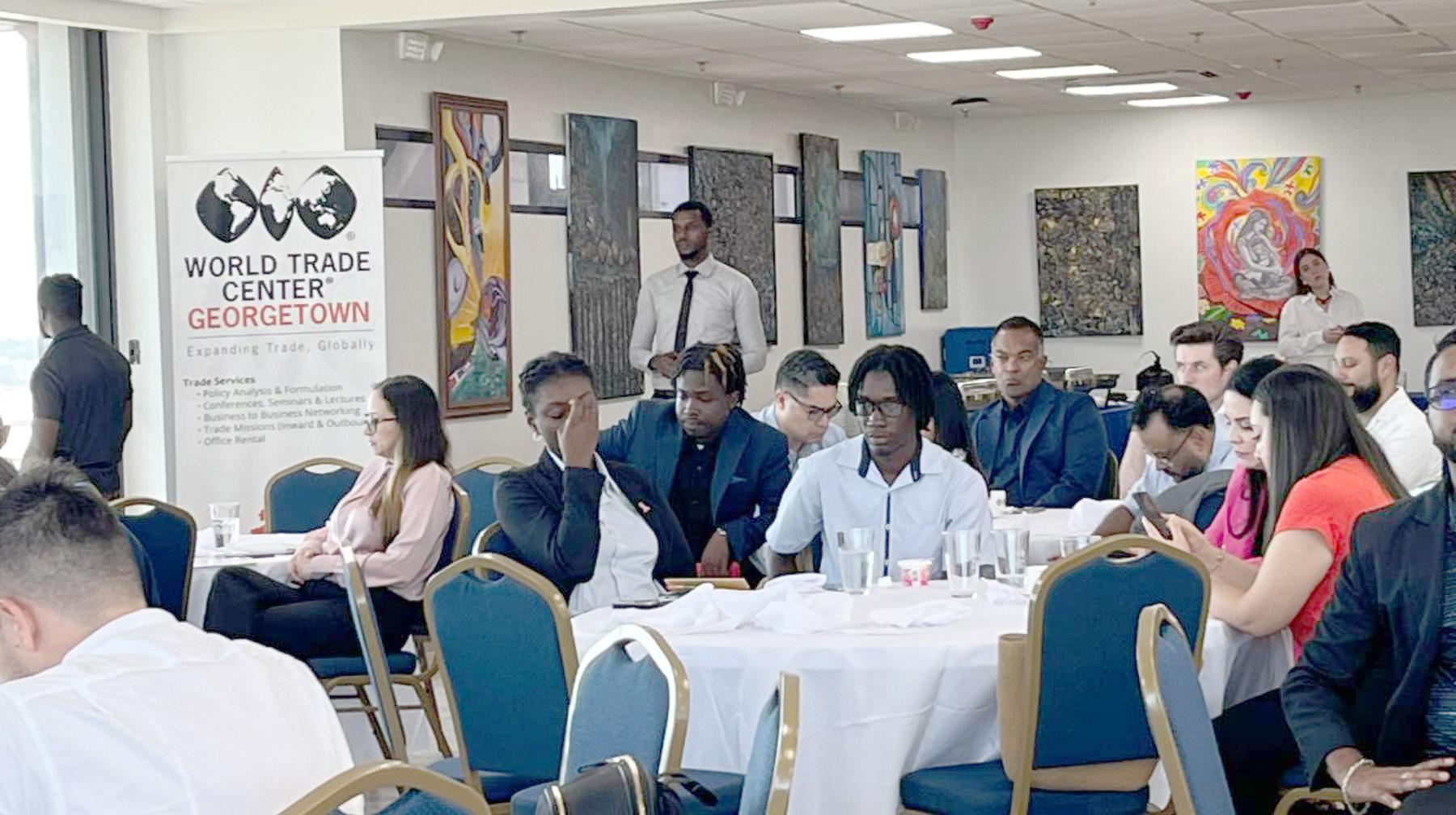
trative bottlenecks that burden local exporters. Sharing her own experiences dealing
with lengthy port clearance procedures, she noted that bureaucracy and poor coor-

dination often increase costs and erode competitiveness.
“The question isn’t only whether we’re ready for business,” Heyliger said, “it’s whether we’re ready for what happens at the port. Every delay or missing document adds to cost and reduces competitiveness.”
Heyliger also simplified key trade concepts—including tariffs, non-tariff barriers, and rules of origin—and demonstrated how understanding trade agreements can unlock preferential access for local producers. She encouraged micro, small, and medium-sized enterprises (MSMEs) to take advantage of emerging support through WTC Georgetown, CARICOM, and new partnerships with the African and European Unions.
From a regional industry perspective, Vaughn Renwick, Chief Executive Officer of the West Indies Rum & Spirits Producers Association (WIRSPA), highlighted the success of the Caribbean rum industry as an example of how heritage, collaboration, and strict quality standards can create globally respected brands.
“Rum tells a story of heritage, compliance, and market evolution,” Renwick said. “From bulk exports to premium global brands, our success depends on quality, rules of origin, and strong
geographical identity — lessons that apply across all export sectors.”
He also praised Guyana’s ongoing investments in sugar and molasses production, noting that these efforts support regional value chains. Renwick further acknowledged the growing role of women in the rum industry, including several master blenders at Demerara Distillers Limited.
The seminar concluded with a strong call for enhanced collaboration among exporters, trade agencies, and regional institutions to streamline border procedures, reduce costs, and foster a culture of trade readiness.
“The big companies can defend themselves,” Ambassador Totaram said in closing. “But smaller enterprises need partnership, training, and supportive policy environments to compete — and that’s exactly where the World Trade Centre Georgetown can make a difference.”
The seminar formed part of WTC Georgetown’s official launch activities, connecting Guyanese businesses to a global network of more than 300 World Trade Centres worldwide. Through these linkages, WTCG aims to create new pathways for trade facilitation, training, and international investment opportunities across the region.


THE 20th Central Committee of the Communist Party of China (CPC) convened its fourth plenary session in Beijing from Monday to Thursday.
Participants at the session deliberated over and adopted the Recommendations of the CPC Central Committee for Formulating the 15th FiveYear Plan for Economic and Social Development, according to a communique of the session released on Thursday.
The Political Bureau of the CPC Central Committee presided over the meeting. Xi Jinping, general secretary of the CPC Central Committee, delivered important addresses, according to the communique. The participants heard and discussed a report presented by Xi on the work of the Political Bureau.
Xi also delivered explan-
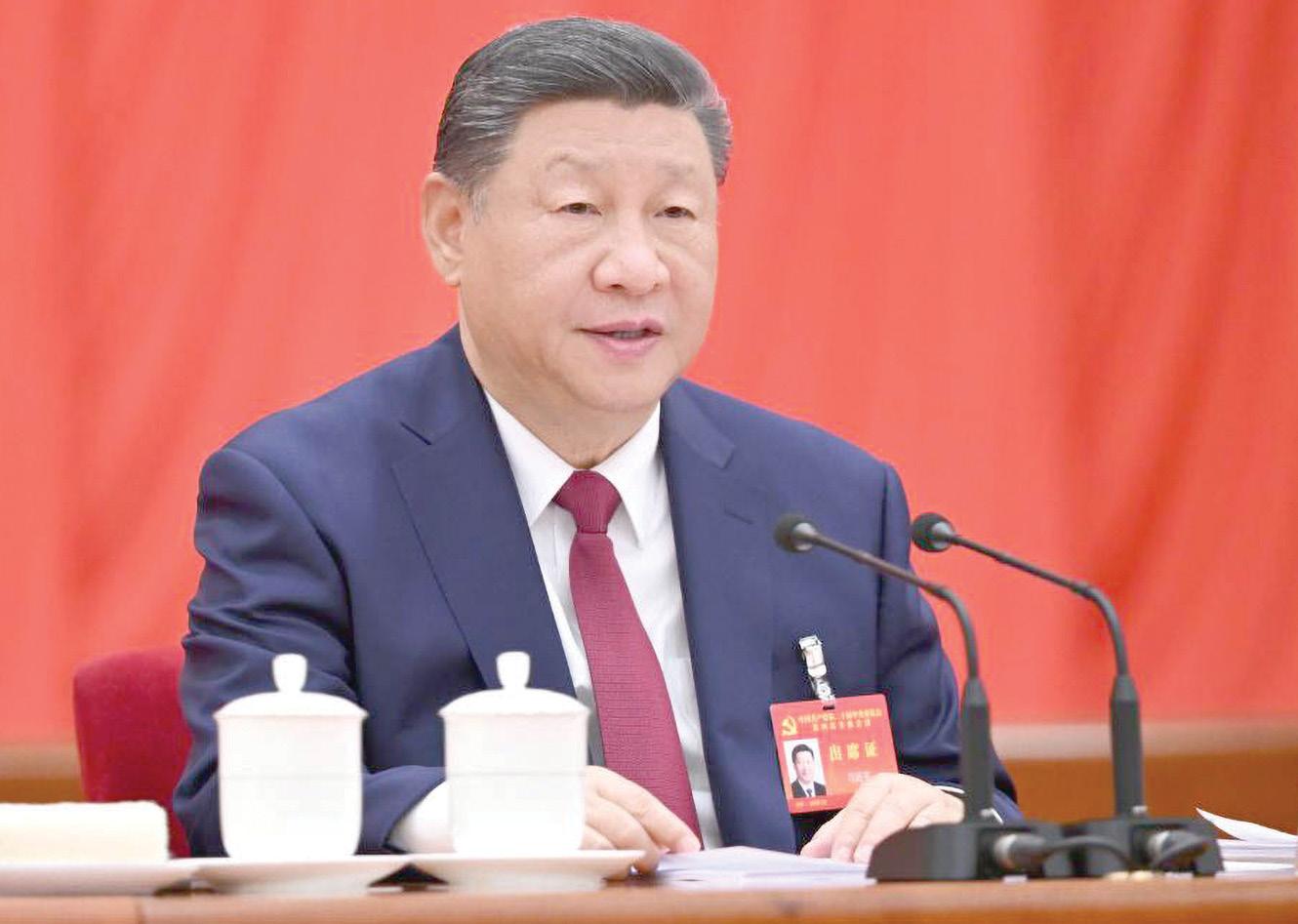
Xi Jinping, general secretary of the Communist Party of China (CPC) Central Committee, delivers an important address at the fourth plenary session of the 20th CPC Central Committee in Beijing, capital of China. The 20th Central Committee of the CPC convened its fourth plenary session in Beijing from Monday to Thursday. (Xinhua/Xie Huanchi)
atory remarks on the draft recommendations. At the session, the CPC Central Committee fully af-
firmed the work of the Political Bureau since the third plenary session of the 20th CPC Central Committee.

The Political Bureau of the Communist Party of China (CPC) Central Committee presides over the fourth plenary session of the 20th CPC Central Committee in Beijing, capital of China. The 20th Central Committee of the CPC convened its fourth plenary session in Beijing from Monday to Thursday. (Xinhua/Ding
China is now on the verge of accomplishing the major objectives and tasks of the 14th Five-Year Plan, according to the communique.
Participants at the session gave a highly positive assessment of China's major TURN TO PAGE 19



FAMILIES and thrill-seekers across Guyana are in for an unforgettable adventure as Caribbean MegaBounce, the Caribbean’s largest inflatable theme park, makes its highly anticipated debut at the YMCA Grounds in Thomas Lands from Friday, October 31 to Monday, November 3, 2025.
The mega attraction, which has captivated crowds in Barbados, Jamaica, and Antigua, promises a fullscale entertainment experience like no other.
Organised by the international Caribbean MegaBounce team in collaboration with Wildfire Entertainment, the event is expected to draw thousands over the four-day holiday weekend.
Founder of Wildfire Entertainment, Jonathan Beepat, described the event as more than just an entertainment spectacle.
“This event isn't just about fun—it's about creating shared spaces where families and communities connect,” Beepat said.
“Guyana’s vibrant and evolving entertainment scene makes it the perfect destination for an event of this scale.”
Spanning thousands of square feet, the inflatable park will feature a 15,000-square-foot main bounce house, a 600-foot four-lane obstacle course, a towering mega slide, and several themed installations.
A live DJ booth will keep the energy high throughout each session.
Beepat emphasised that Caribbean MegaBounce is designed for everyone:
“While kids will be in their element, adults are encouraged to join in too.
Whether you’re challenging your teens on the obstacle course or racing down the mega slide, it’s about families having fun together.”
The fun kicks off on Friday, October 31, from 15:00 hours to 22:00 hours, with extended hours on Saturday, November 1 and Sunday, November 2 from 11:00 hours to 22:00 hours, before wrapping up on Monday, November 3, from 15:00 hours to 22:00 hours.
Admission prices: Children (ages 2–11): $4,000; Adults: $5,000; and Family package (2 adults + 2 children): $16,000.
Each ticket provides unlimited access to all attractions and same-day re-entry privileges, allowing guests to TURN TO PAGE 20

Spanning thousands of square feet, the inflatable park will feature a 15,000-square-foot main bounce house, a 600-foot four-lane obstacle course, a towering mega slide, and several themed installations

development achievements during the 14th Five-Year Plan period (2021-2025), which has marked a momentous and extraordinary period in the country’s development.
The 15th Five-Year Plan period (2026-2030) will be critical, as the country works to reinforce the foundations and push ahead on all fronts toward basically achieving socialist modernisation by 2035, and it will thus serve as a key link between the past and the future, according to the communique.
At present, China remains in a phase of development where strategic opportunities exist alongside risks and challenges, while uncertainties and unforeseen factors are rising.
“All of us in the Party must acquire a deep understanding of the decisive significance of establishing Comrade Xi Jinping’s core position on the Party’s Central Committee and in the Party as a whole and of establishing the guiding role of Xi Jinping Thought on Socialism with Chinese Characteristics for a New Era,” said the communique.
At the session, the CPC Central Committee established the following guiding principles for economic and social development during the 15th Five-Year Plan period: upholding the Party’s overall leadership; putting the people first; pursuing high-quality development; comprehensively deepening reform; promoting interplay between an efficient market and a well-functioning government; and ensuring both development and security.
The CPC Central Committee also set the following major objectives for the 15th Five-Year Plan period: significant advancements in high-quality development; substantial improvements in scientific and technological self-reliance and strength; fresh breakthroughs in further deepening reform comprehensively; notable cultural and ethical progress across society; further improvements in quality of life; major new strides in advancing the Beautiful China Initiative; and further advances in strengthening the national security shield.
China should build a modernised industrial system
and reinforce the foundations of the real economy, said the communique.
The country should achieve greater self-reliance and strength in science and technology and steer the development of new quality productive forces.
It should build a robust domestic market and work faster to foster a new pattern of development, said the communique.
China should move faster to develop a high-standard socialist market economy and boost the momentum for high-quality development.
The country should promote high-standard opening up and create new horizons for mutually beneficial co-operation. It should accelerate agricultural and rural modernisation and take solid steps to advance all-around rural revitalisation.
China should refine its regional economic layout and promote coordinated regional development, according to the communique.
The country should inspire the cultural creativity of the entire nation and foster a thriving socialist culture.
China should work harder to ensure and improve public well-being and promote prosperity for all, said the communique.
The country should accelerate the green transition across the board in an effort to build a Beautiful China.
It should modernise its national security system and capacity and advance the Peaceful China Initiative to a higher level.
China should work to achieve the centenary goals of the People’s Liberation Army on schedule and modernise national defence and the armed forces, according to the communique.
The whole Party and all Chinese people should be united in a concerted endeavour to fulfil the 15th Five-Year Plan.
Studying and implementing the guiding principles from this plenary session represent a major political task for the entire Party and nation, both at present and in the period to come.
“To run the country well, we must first run the Party well; only a Party that is thriving can make our country strong,” said the communique.
FROM PAGE 15
Participants at the session carried out an analysis of the present situation and the tasks China faces. It was highlighted that the country must remain firmly focused on accomplishing this year’s targets for economic and social development.
The session decided to add Zhang Shengmin as a vice chairman of the CPC Central Military Commission (CMC), according to the communique.
The session decided in accordance with the Party’s Constitution that empty seats on the Central Committee will be filled by alternate members Yu Huiwen, Ma Hancheng, Wang Jian, Wang Xi, Wang Yonghong, Wang Tingkai, Wang Xinwei, Wei Tao, Deng Yiwu, Deng Xiuming and Lu Hong.
The session deliberated over and adopted the inspection report of the CPC Central Commission for Discipline Inspection on grave violations of Party discipline and state laws by Tang Renjian, Jin Xiangjun, Li Shisong, Yang Fasen and Zhu Zhisong.
At the session, the CPC CMC’s inspection report on grave violations of Party discipline and state laws involving He Weidong, Miao Hua, He Hongjun, Wang Xiubin, Lin Xiangyang, Qin Shutong, Yuan Huazhi, Wang Chunning and Zhang Fengzhong was deliberated over and adopted.
The Political Bureau’s previous decision to expel He Weidong, Miao Hua, Tang Renjian, Jin Xiangjun, He Hongjun, Wang Xiubin, Lin Xiangyang, Qin Shutong, Yuan Huazhi, Wang Chunning, Li Shisong, Yang Fasen, Zhu Zhisong and Zhang Fengzhong from the Party was confirmed at the session.
At the session, a call was issued to the whole Party, the entire military, and Chinese people of all ethnic groups to rally more closely around the Party’s Central Committee with Xi at its core, work hard together toward the goal of basically realising socialist modernisation, and continue breaking new ground in the drive to build a great country and advance national rejuvenation on all fronts through Chinese modernisation.

POLICE in Regional Division One have detained a 29-year-old man after discovering over one kilogram of suspected cannabis during an operation at Bamboo Landing, North West District, on Friday, October 24, 2025.
According to a police press release, a team of ranks led by a Gazetted Officer observed the man acting suspiciously while carrying a haversack.
A search was conducted,
during which a quantity of leaves, seeds, and stems suspected to be cannabis were found.
The suspect was taken to the Matthew’s Ridge Police Station, where the suspected narcotics were weighed in his presence and amounted to approximately 1,182 grams. The substance was subsequently marked, sealed, and lodged as evidence.
The man remains in custody as investigations continue.


POLICE in Regional Division # 2, in collaboration with the Guyana Fire Service, are investigating a fire that occurred at the Suddie Public Hospital at about 03:30 hours on Saturday, October 25, 2025.
Police Headquarters reported that the fire started under a shed near the hospital boardroom and was contained by on-site security before being fully extinguished by the Fire Service.
Two wheelchairs and packaging valued at approximately GY$120,000 were
destroyed. No injuries were reported, and hospital operations were not affected.
“Ranks from the Suddie Police Station visited and processed the scene.
One person is in police custody assisting with the investigation,” the police reported.
The Regional Administration has commended the swift response of the security guards and fire officials, noting that their prompt actions prevented what could have been a far more serious situation.
come and go freely throughout the day.
Event sponsors Beepats and Sterling Products will enhance the experience with exciting giveaways, including Santal juices, Goya cookies, and ice cream treats for kids.
All participants are required to wear socks while on the inflatables for safety reasons — “No socks, no bouncing,” Beepat reminded.
Tickets are available at: Beepats, Regent Street; Giftland OfficeMax Department
FROM PAGE 18
Store, Giftland Mall, Turkeyen; Mattai’s The Food Mart, Water & Hope Streets; YMCA Grounds, Thomas Lands; and Bad Monkey Merch Stores at Amazonia Mall; Giftland Mall, Movietown Mall, and Leonora Mall
With just days to go before opening, excitement is already mounting as Georgetown prepares to host what organisers are calling “the Caribbean’s biggest bounce party ever.”
WITH construction progressing on 115 three-bedroom flat homes and 60 young professional units at Leonora and Groenveldt, Region Three, Chief Executive Officer of the Central Housing and Planning Authority (CH&PA), Dr. Martin Pertab, conducted a site visit to assess ongoing works and engage with contractors, on Saturday.
A press release from the Ministry of Housing noted that Dr. Pertab was accompanied by a technical team from CH&PA, including engineers and a surveyor. The visit formed part of the agency’s continuous monitoring efforts to ensure efficiency and
accountability as it advances the government’s housing target of 40,000 housing units in the next five years.
Emphasising the transformative impact of homeownership, Dr. Pertab underscored that the national housing programme goes beyond providing shelter—it drives economic growth and empowers citizens.
“It's not only a key to a shelter, it symbolises opportunity, it symbolises empowerment, and it symbolises independence," the CEO was quoted as saying.
In addition to the housing units, supporting infrastructure such as roads, water, and electricity networks are
also being developed. The CH&PA expects occupancy of the new homes to begin next year. The CEO noted that achieving occupancy requires a coordinated approach among builders, utility agencies, financial institutions, and beneficiaries.
Dr. Pertab also pointed to the housing sector’s broader economic impact, explaining that home construction is generating significant employment across various trades, such as masons, carpenters and block-makers. During the visit, the CEO also inspected several completed elevated young professional homes at Leonora.


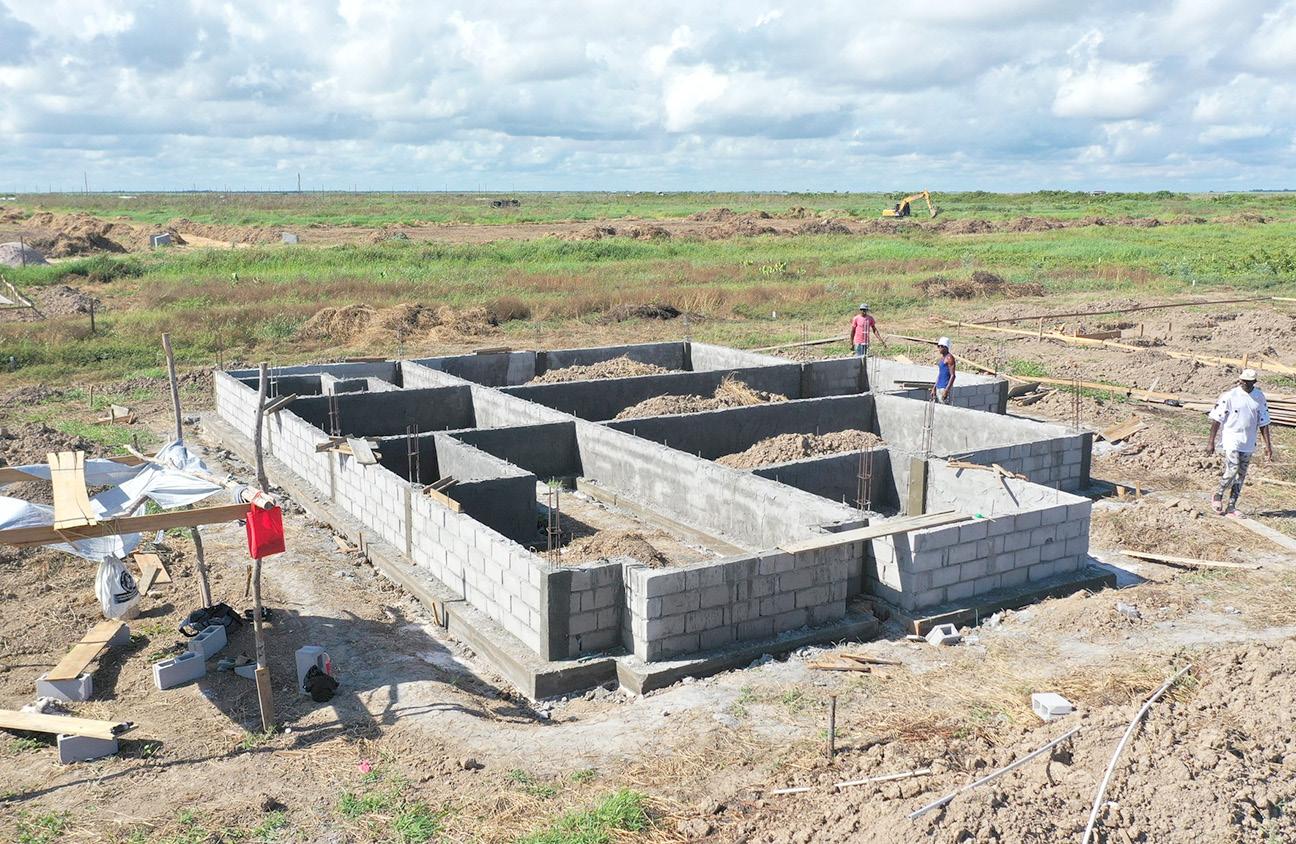
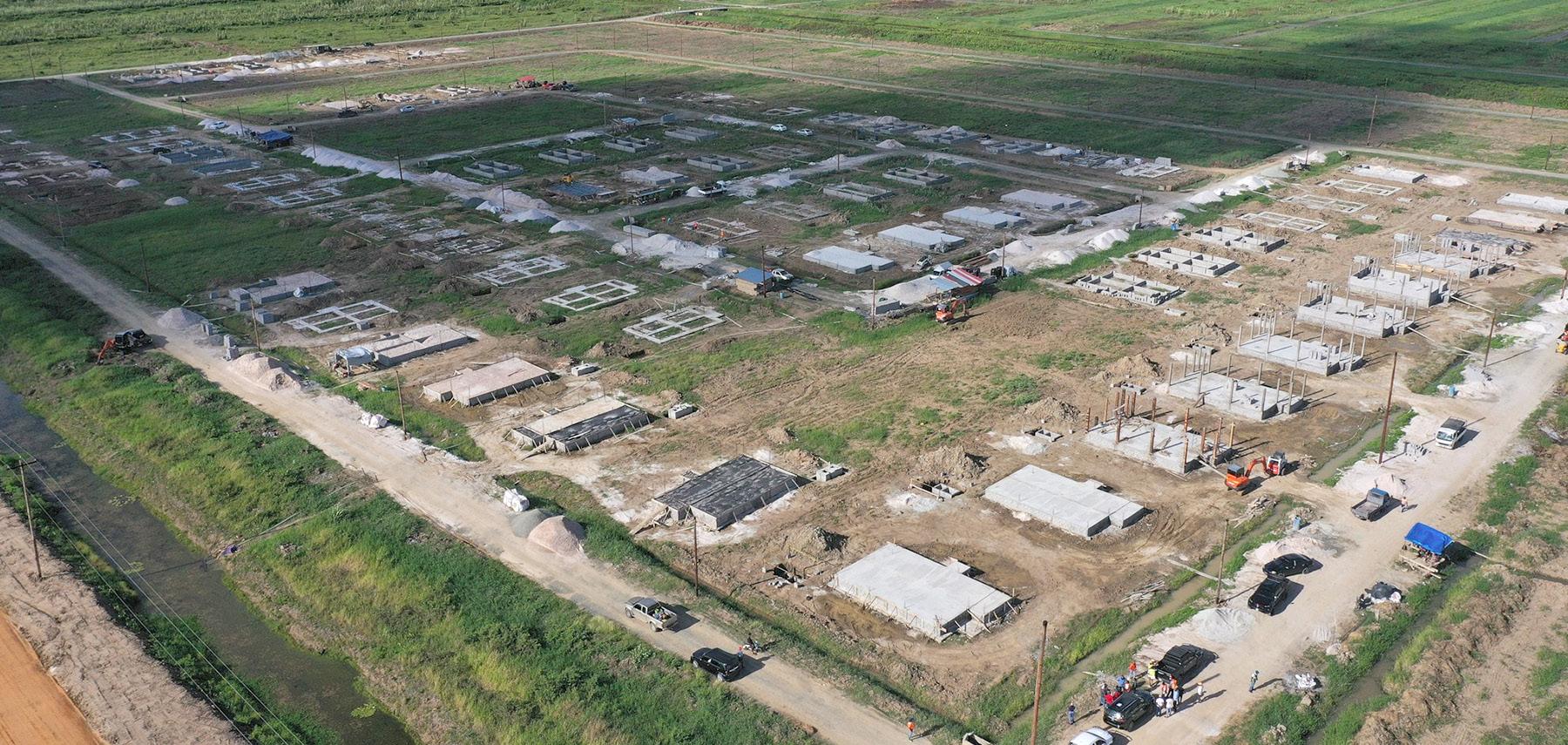
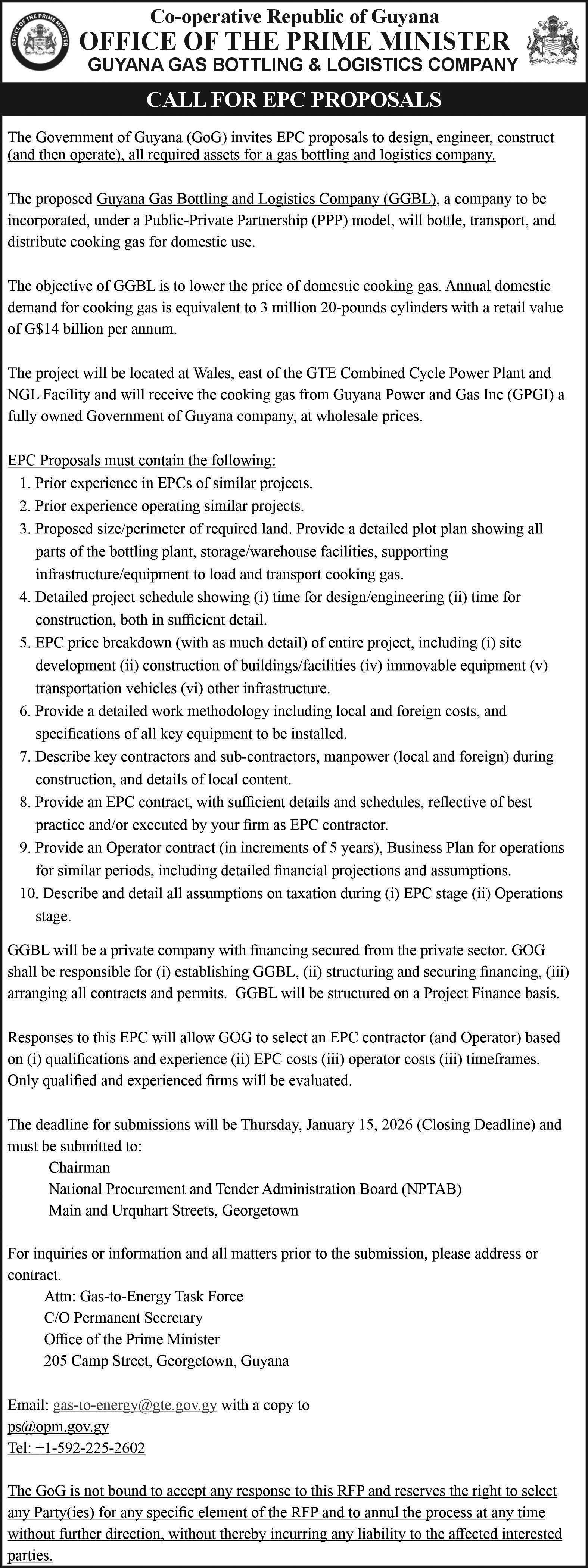
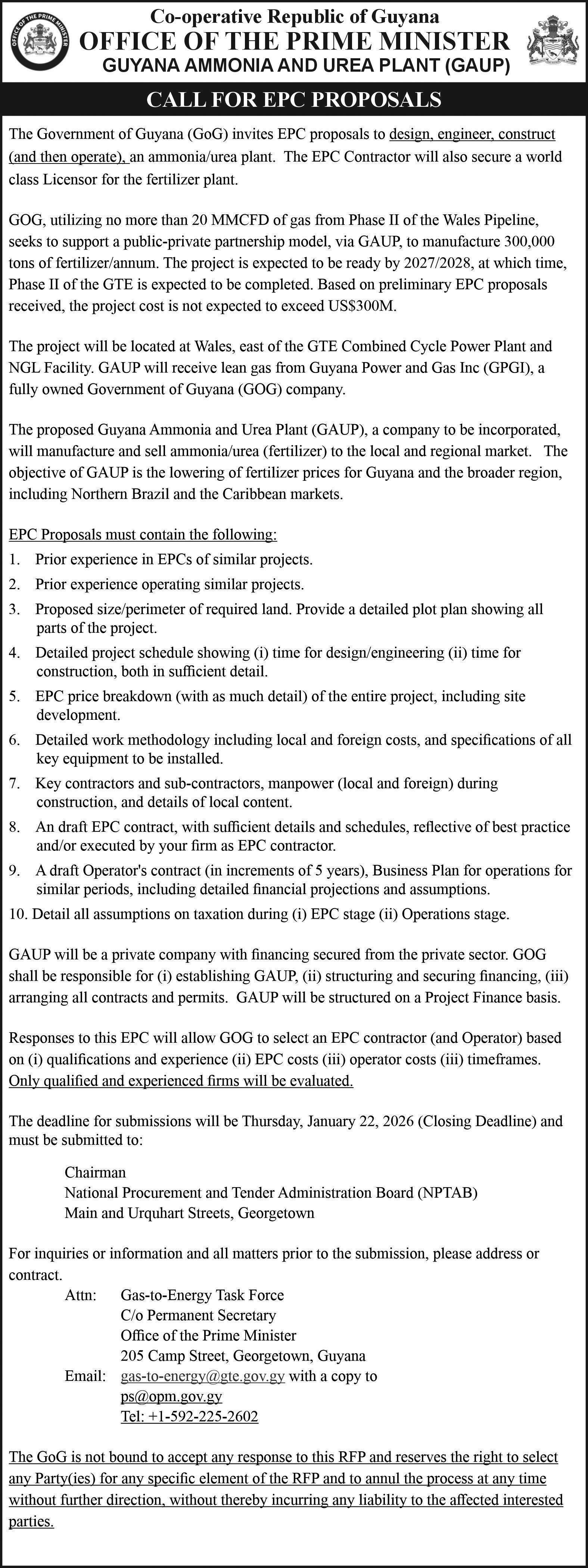

The weigh-in-motion scales, pictured under this truck, measure the weight of trucks and provide printouts indicating whether vehicles comply with the regulations
THE Government of Guyana, through the Ministry of Public Works, has underscored that true development goes beyond building infrastructure - it requires preserving it.
On Thursday last, the ministry began enforcing the 15-tonne per axle weight limit for trucks, marking the first phase of a national effort to protect the country’s roads. During a public demonstration and inspection exercise on High Street, Public Works Minister, Juan Edghill, stressed the importance of compliance, outlining measures that will ensure the new regulation is strictly upheld.
The robust enforcement plan developed by the ministry will involve mobile teams dispatched to multiple locations across the country. These teams will be equipped with the necessary tools to inspect and weigh trucks.
“I would like to inform the nation that mobile teams will be dispatched on various roads. In the next couple of days, every trucker, every transportation provider, whether it's sand, aggregate, cement, steel, whatever is the merchandise or material that you are using, [there]will be testing and enforcing [of] the weight limit,” the minister explained. Minister Edghill emphasised that the initiative is a way of protecting the country’s infrastructure while it undergoes development, adding, “We cannot as a country continue to build infrastructure, roads and bridges, and shortly after have them damaged because of the indiscriminate use and carrying of excessive loads by trucks and vehicles.”
During the demonstration, the ministry utilised weighin-motion scales, which measures the weight of trucks and
provide printouts indicating whether vehicles comply with the regulations.
“These weigh-in-motion scales will test both the front and the back. You will get a printout, and it will show you exactly what is the tolerance. You will be able to know if it is more than what is allowed and what is carried,” Minister Edghill stated.
He also outlined the enforcement schedule, noting that the initial 48-hour period would serve as a trial, while the following days would see the initiative fully rolled out across Guyana.
“In the next couple of days, we will be documenting as we go along. Actual enforcement will begin once these 48 hours of trial are completed,” he said.
Citing the project as a decisive but necessary move, Minister Edghill warned operators that trucks exceeding the limit will face penalties.
“Once you are caught carrying more than 15 tonnes per axle, you will remain parked until you remove the weight, and then you will be prosecuted by the police as well. So, we are giving everybody notice,” he said.
The ministry plans to implement the enforcement programme across the country, including major highways and village roads. As the minister explained, truck drivers will see ministry weight testing officials, working with the police force at busy areas like the Linden Soesdyke highway and the East Bank corridor.
While a first for Guyana, the initiative is expected to have a major positive impact on the lifespan of the nation’s infrastructure, aimed at safeguarding roads, highways, bridges, and village streets throughout the country.




ENGLISH RACING TIPS
FONTWELL

AINTREE
08:15

SOUTH AFRICA RACING TIPS
GALWAY
ROHIT Sharma and Virat Kohli enjoyed a historic evening at the SCG as they denied Australia a series sweep on Saturday.
Rohit scored his 50th international century while Kohli went past Sangakkara’s tally to become the second highest run-getter in ODI cricket. They added their first century stand since January 2020 (any format) and avoided the ignominy of a 3-0 series defeat.
This ODI batting clinic came after Harshit Rana’s four-wicket haul headlined a strong bowling performance that restricted Australia to a sub-par total. Matthew Renshaw got his maiden ODI fifty but batters around him were found wanting as India bundled out the hosts for 237.
Only for the second time in 27 ODIs as captain, Mitchell Marsh chose to bat first. The last time he did it, Australia posted 431/2 against South Africa last August. Marsh and Travis Head took on the trio of Rana, Mohammed Siraj and Prasidh Krishna - playing in place of Arshdeep Singh, in the PowerPlay to roll out the carpet for another big batting effort.
In the 10th over however, Siraj stopped Head in his tracks, shortly after he got to 3000 ODI runs. The left-hander attempted to cut a ball outside the offstump but hit straight to Krishna at backward point. The scoring rate dipped a bit from here but Marsh attempted to throw Kuldeep Yadav off his lengths with two boundaries. But right after the drinks break, Axar Patel got one ball from
round the stumps to go with the angle and hit the stumps to send the Aussie skipper packing for 41.
Matt Renshaw and Matthew Short kickstarted the next big alliance. Washington Sundar and Axar tied the two batters down in a tight spell of spin bowling, which led Short to attempt a breakaway shot. He reached for a ball on the off-stump and tried to sweep it away but hit towards Kohli, who reacted quickly and got behind the ball to take the catch.
Renshaw and Alex Carey got together next, and the scoring rate went down further. Kuldeep nearly ended Carey’s stay on eight when the keeper-batter decided to break the shackles by going after the spinner.
He mistimed a big shot and hit straight to Krishna at long-on, only for the pacer to spill a simple catch.
Carey’s exit was eventually down to an incredible catch from Shreyas Iyer in the 34th over. He ran back from backward point, reached out and dived to complete the catch. In the process, he hurt his left rib cage because of the way he landed and had to go off the field.
Later, the BCCI confirmed an injury and that he was taken to hospital for further assessment. Just a few deliveries before this, Renshaw reached his maiden ODI fifty, but his exit a couple of overs later hastened the end of the Australian innings.
Sundar trapped him leg before via a review after Renshaw had charged down the track. Harshit and Kuldeep dismissed Mitch Owen and Mitchell
Starc in successive overs to leave Australia down to 201/7. Krishna and Rana then mopped up the tail by the 47th over.
Rohit and Shubman Gill then gave India a confident start, soaring past the PowerPlay at 68/0. Gill then nicked one behind off Josh Hazlewood on the first ball of the 11th over to bring Kohli to the middle, expectedly, a rousing welcome. He did a mini celebration in jest after getting his first run and avoiding a hat-trick of ducks. He went on to bat for the remainder of the chase, and hit the winning runs in the 39th over.
Kohli was troubled early on by Hazlewood, and even top-edged a short ball that went to the vacant fine leg region but he soon locked in to bat comfortably in the partnership. In the 21st over, Rohit reached his 60th ODI half-century in the 21st over as the duo cruised along in chase.
Nathan Ellis came close to breaking the stand when they sent an LBW appeal against Kohli upstairs, but umpire’s call kept Kohli in the middle.
Soon Rohit showed a sense of urgency to wrap up the chase as he went after Cooper Connelly and Adam Zampa. Kohli got to his 75th ODI fifty, and a ball later, the 19th 100-run partnership between the two came up. In the 32nd over, Kohli scored his 14,235th run to usurp Sangakkara to second spot in ODIs.
An over later, Rohit reached his 33rd ODI ton. He then hit Short for a six and a four in an over while Kohli ramped a short one from Ellis to secure the nine-wicket victory. (Cricbuzz)
From Page 32
Dindyal, who celebrated his 21st birthday earlier this month, reached his century from 144 balls with 12 boundaries, which included a single six.
sent Yeudistir Persaud (0) stumps for a walk before Van Lange bowled Thaddeus Lovell (1). Wilson picked up his fifth wicket when he bowled Devon Lord for a duck as GCC slumped to 156-9.
the
and
is scheduled to commence at 09:00 hours.

...Becomes fourth player to start season with back-to-back 40-point games
WHEN LeBron James was ruled out for the start of the Los Angeles Lakers’ season, everyone knew that would mean a full plate for Luka Dončić. So far, the Slovenian star is obliging.
In the Lakers’ second game of the season, Dončić posted 49 points on 14-of-23 shooting, 11 rebounds and 8 assists in a 128-110 win over the Minnesota Timberwolves. The win improves the Lakers’ record to 1-1.
It was nearly Dončić’s eighth career 50-point game, which seemed inevitable once he reached 48 points and remained in
a blowout with more than five minutes left. However, he then missed his next two shots and split a pair of free throws, leaving him with 49 when head coach JJ Redick finally pulled him.
Dončić had to settle for merely being the fourth player in NBA history to open the season with back-to-back 40-point games, joining Anthony Davis, Michael Jordan and Wilt Chamberlain. Dončić posted 43 points, 12 rebounds and 9 assists in the Lakers’ season-opening loss to the Golden State Warriors.
He’s also the first player in NBA history to clear 40 points, 10 rebounds and 5 assists in each of his first two games.
Unlike in that opener, the Lakers gave Dončić some help. Austin Reaves posted 25 points, 11 assists and 7 rebounds, while Rui Hachimura had 23 points. Deandre Ayton bounced back from a rough Lakers debut with 15 points and eight rebounds.
It’s unclear when James will return from his bout with sciatica, but it looks like these Lakers will have to make do until at least mid-November. (Yahoo Sports)
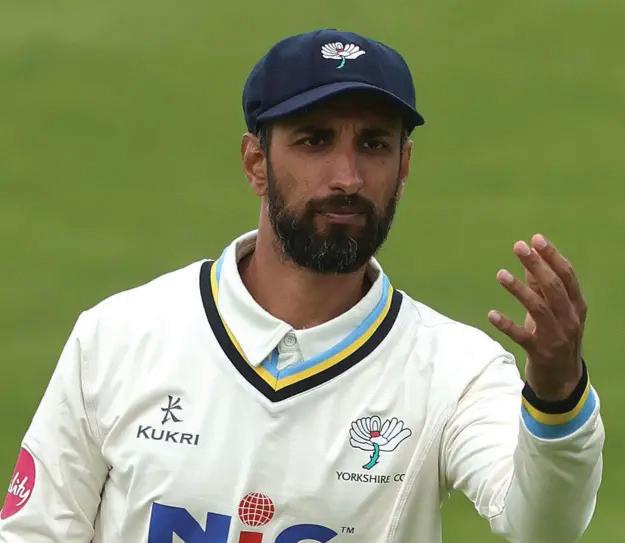
SHAN Masood has been appointed Consultant of International Cricket at the Pakistan Cricket Board (PCB). It is a rather unique situation, with the country’s current Test captain also being elevated to a position of authority within the board’s administrative setup. Sources in Pakistan cricket say the announcement was made by PCB chairman Mohsin Naqvi during a dinner meeting with Prime Minister Shehbaz Sharif who was visited on Friday by the Pakistan team as well as the touring members of the South African squad.
The PCB recently advertised for the position of Director of Cricket after Usman Wahla was suspended from the role for mishandling of the Handshakegate during the Asia Cup league fixture between India and Pakistan in Dubai last month. Wahla was reinstated to the position but it is understood that is now being moved another department, most likely the PSL, following the new role for Masood.
Masood (36) has played 44 Tests, apart from nine ODIs and 19 T20Is. MisbahUl-Haq was considered favourite for the role. Masood ascends a position at a time when Pakistan are not known to play too many Tests.
They just completed a two-Test home series against South Africa and their next Test series is in March, after the Twenty20 World Cup, in Bangladesh.
In 12 months and since October last year, Pakistan have played nine Tests, less than even Zimbabwe, who have featured in 11 Tests. India (15), England (12), Australia and South Africa (both 11) have played more than Pakistan.


TWO Australia cricketers were “approached and touched inappropriately” while in India for the Women’s Cricket World Cup, Cricket Australia (CA) has said.
The incident occurred in Indore on Thursday, the morning after Australia had beaten England, as the players were walking to a cafe.
Police in Indore confirmed a man has been arrested.
“We can confirm two members of the Australian Women’s Team were approached and touched inappropriately by a motorcyclist while walking to a cafe in Indore,” Cricket Australia said in a statement.
“The matter was reported by team security to police who are handling the matter.”
Rajesh Dandotiya, additional deputy commissioner of police (crime) in Indore, told BBC News Hindi: “The accused followed the women players for some distance and kept passing lewd remarks.
“He then moved his motorcycle closer... making inappropriate physical contact. The accused was identified through CCTV footage and arrested.”
Australia are playing South Africa in their final group-stage match of the tournament on Saturday in Indore.
Devajit Saikia, honorary secretary of the BCCI, said: “This is a deeply regrettable and isolated incident. India has always been known for its warmth, hospitality and care towards all guests.
“We maintain a zero-tolerance policy towards such acts. We appreciate the swift and effective action taken by the Madhya Pradesh Police in apprehending the accused. The law will take its due course to ensure justice is served.” (BBC Sport)
JONATHAN Trott has launched a scathing attack on Afghanistan Cricket Board (ACB) over its interference in team selection.
“The sad thing for me, though, is the fact that I haven’t been able to have any input on the squad. I haven’t had any communication with the top management (of the ACB) or with the (chief) selector,” the head coach of the Afghanistan team said after his side lost the one-off Test to Zimbabwe by an innings and 73 runs in Harare recently.
“I’ve been trying to get hold of them for the last couple of weeks. And the chairman, I’ve been trying to get hold of him and I haven’t been able to get any input back on the selection, not only for this squad but for the last few squads since the Asia Cup didn’t go our way. There has sort of been no communication at all.
“So that’s one of those things that I think as a coach, you should have a little bit of idea or a little bit of input.
“Certainly the playing XI, which for this game again wasn’t the case. When you don’t
have that input, like I have had in other teams and other tournaments, it is really sad,” Trott (44) was quoted as saying in Zimbabwe-based Sportscast website.
Afghanistan has been in the news recently for pulling out of a tri-series in Pakistan following the deaths of three of its club cricketers, who were killed in cross-border firing from Pakistan in the Paktika Province.
Among many decisions, Afghanistan decided to rest Rashid Khan for the Test.
“It’s no coincidence that every time Afghanistan has won a Test match, Rash has been playing. We saw Rashid playing the last time at the end of last year and Afghanistan won that game.
“You need your best players in a Test match. But I understand the amount of toll on his body because of the lots of cricket he plays.
“We need him to be fresh for the stuff coming up, certainly the T20 World Cup, so for me it’s understandable. It gives opportunities to younger players. It’s unfortunate they were not able to do it in this game.
“Hopefully they’ve learnt from the experience and will come back better players when they get the opportunity again,” the South Africa-born former England batter said.
Trott said he is frustrated and not sure about his future with the team.
“Well, I don’t know, I’d like to open up communication. I’ve been told my tenure is sort of until the T20 World Cup so that’s obviously a couple of more months, then after that look if the job description has changed with regards to being the head coach.
“So my focus now is solely on gaining a bit of momentum, certainly the upcoming T20 series against Zimbabwe who are going to be tough to beat at home.
“It’s going to be great competition and a great series in the short format so that is exciting for us. That is what we can focus on in the short term and go from there really.”
Cricbuzz reached out to a spokesman of the ACB for a comment.
The teams will now play three T20Is on October 29, 31 and November 2, all at Harare Sports Club. (Cricbuzz)
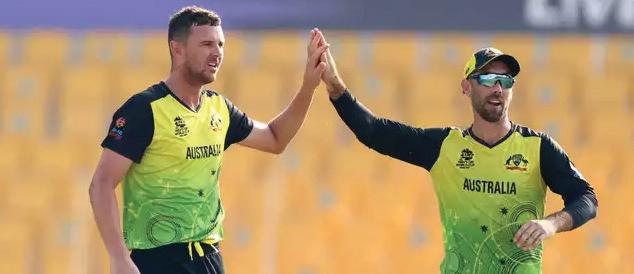
All-rounder Glenn Maxwell (right) is set to return to Australia’s ODI squad
GLENN Maxwell is set to return from a fractured wrist for Australia’s upcoming T20I series against India, while 20-year-old quick Mahli Beardman could be handed a maiden international cap as selectors continued to shuffle players ahead of the home Ashes.
Marnus Labuschagne, Josh Hazlewood and Sean Abbott have been released to play Sheffield Shield cricket to fine-tune for the Test series against England, which begins on November 21.
Maxwell, who injured his wrist while bowling in the nets before the T20Is in New Zealand last month, is expected to feature in the final three games of the T20I Series against India.
However, Labuschagne, who was a late addition to the ODI squad in place of the injured Cameron Green but didn’t play in either of the first two matches, will return to Queensland for their Shield clash against New South Wales at the Gabba, a fixture that will also feature Steve Smith for the Blues.
NSW captain Jack Edwards has been drafted into the ODI squad for the third match at the SCG on Saturday, alongside left-arm spinner Matt Kuhnemann, who returns after missing the Adelaide ODI.
Josh Philippe, who replaced Maxwell in New Zealand and was later called up as cover for the injured Josh Inglis, has also been added to the T20I squad for the India series beginning October 29 in Canberra. Inglis, recovering from a calf strain, is expected to rejoin the ODI group for the Sydney game.
Meanwhile, Beardman’s inclusion is the standout among the new faces. The Western Australia pacer, part of the U-19 World Cup-winning side last year and Player of the Final for his 3 for 15, has just five List A games and two BBL appearances so far.
He has impressed this domestic season with five wickets in two One-Day Cup matches and could become the latest in Australia’s line of fast-tracked young talents after Xavier Bartlett, Cooper Connolly and Mitch Owen. Hazlewood and Abbott, meanwhile, will
feature for New South Wales in their Shield clash against Victoria at the SCG from November 10.
Hazlewood is available for only the first two T20Is against India, while Abbott will also play the third before heading back to red-ball duties.
With Pat Cummins still recovering from a back issue and Cameron Green gradually resuming bowling after surgery, Abbott remains in the mix to bolster Australia’s pace stocks this summer alongside Michael Neser and Brendan Doggett. (Cricbuzz)
ODI squad changes
IN: Jack Edwards, Matt Kuhnemann
OUT: Marnus Labuschagne
T20I squad changes
Josh Hazlewood (after game 2), Sean Abbott (after game 3).
SCOTT McTominay and Kevin de Bruyne scored as defending champions Napoli beat title rivals Inter Milan and moved to the top of the Serie A table.
The hosts led at the Stadio Diego Armando Maradona through De Bruyne’s first-half penalty, before McTominay and Frank Anguissa struck to secure Napoli’s first win in three games - after a league defeat by Torino and the midweek 6-2 thrashing by PSV Eindhoven in the Champions League.
But in a setback for Antonio Conte’s side, Belgian midfielder De Bruyne - who has four goals in eight games since leaving Manchester City - limped off the pitch soon after scoring.
It was Inter who made the better start as their captain Lautaro Martinez was denied from close range by Napoli goalkeeper Vanja Milinkovic-Savic. But Napoli went ahead through De Bruyne’s penalty in the 33rd minute after Henrikh Mkhitaryan fouled Giovanni di Lorenzo inside the box.
It was the final involvement of the evening for both De Bruyne and Mkhitaryan as the former Manchester United midfielder was swiftly taken off by Inter manager Cristian Chivu. Inter went close to an equaliser in the closing stages as Denzel Dumfries brushed the woodwork with a towering header.
But it was Napoli who doubled their lead nine minutes after the restart when Scotland international McTominay ran on to a long ball from Leonardo Spinazzola and hit a first-time effort past Yann Sommer from the edge of the box.
Hakan Calhanoglu reduced the deficit for

the visitors from a penalty after a handball from Alessandro Buongiorno, only for Anguissa to restore Napoli’s two-goal advantage within seven minutes.
Napoli’s sixth win in eight games saw
them dethrone AC Milan from the league’s summit with a one-point lead.
McTominay had scored in Napoli’s 2-0 win over Cagliari in their final game of the 2024-25 season to guide the club to their
MCLAREN’S Lando Norris gave his title hopes a boost by taking pole position at the Mexico City Grand Prix.
Title rivals Max Verstappen and Oscar Piastri will start the race fifth and seventh, as both Ferrari drivers and Mercedes’ George Russell muscled in on the championship fight. Norris beat Ferrari’s Charles Leclerc by 0.262 seconds, while Lewis Hamilton secured his best grand prix qualifying position of the season in third. Verstappen, struggling with his Red Bull through the Esses, was 0.484secs off the pace in fifth and beaten by Russell by just 0.036secs. Piastri, off the pace all weekend, briefly moved up to third with his final lap until he was beaten by a succession of other drivers.
He qualified eighth, behind Mercedes’ Kimi Antonelli and Williams driver Carlos Sainz, but is promoted a place on the grid by the Spaniard’s five-place grid penalty for causing a crash in Austin last weekend.
Norris looked the favourite for pole going into the final shootout for the top 10 grid positions after a strong weekend, but Leclerc gave him a fright when he pulled out a superb lap on his first run to take provisional pole. Although Leclerc also improved on his own final run, the Briton eclipsed the Ferrari driver with a scintillating lap to take his first pole since the Belgian Grand Prix back in July. (BBC Sport)


BRYAN Mbeumo scored twice as Manchester United survived a late scare against Brighton to claim a third successive Premier League win for the first time since February 2024, moving them up to fourth in the table.
United were cruising after an hour thanks to goals from Matheus Cunha, who broke his 16-match scoring drought by netting for the first time for his new club, Casemiro’s deflected effort and Mbeumo’s neat finish.
But Danny Welbeck’s brilliant free-kick pulled one back against his old club with 16 minutes left. Then, two minutes into the seven added, Charalampos Kostoulas flicked home a near-post header. Suddenly there were some worried faces in the United ranks and it took an even later effort from Mbeumo, drilled into the roof of the net from 12 yards, to ease the tension.
They may only stay there for a matter of hours but United suddenly find themselves in a much better state than three weeks ago, when it was felt by many a home defeat by Sunderland would have left head coach Ruben Amorim clinging to his job.
Now there is a hint of swagger about Amorim’s team, who should have won by more and certainly with no need for the worries at the end.
Cunha’s first goal for club or country since April was superb, taking Casemiro’s short pass on the edge of the area before curling an inch-perfect low shot into the bottom corner.
Casemiro benefitted from a huge slice of luck for the second when his shot, which might have been off target, struck Yasin Ayari on the back, completely wrong-footing Bart Verbruggen as it flew into the opposite corner.
Verbruggen denied Benjamin Sesko and Bruno Fernandes, who was making his 300th United appearance, before Mbeumo followed his goal at Liverpool by driving home his third of the season after an hour.
Welbeck’s brilliant free-kick followed a Patrick Dorgu foul on Yankuba Minteh the Brighton bench were adamant should have resulted in a red card.
Referee Anthony Taylor gave a yellow, video assistant referee (VAR) Michael Oliver agreed. Who knows what would have happened if he hadn’t.
As it turned out, Brighton scored again anyway. But so did United, who took the points - again. (BBC Sport)

BRENTFORD heaped further misery on Premier League champions Liverpool with a fully deserved victory at Gtech Community Stadium.
An emphatic midweek triumph at Eintracht Frankfurt in the Champions League ended a sequence of four successive defeats in all competitions for the Reds - but it proved to be a false dawn as the weaknesses that have plagued Arne Slot’s side this season surfaced yet again.
Michael Kayode’s lethal long throw exposed Liverpool’s shaky rearguard in the fifth minute, with Dango Ouatarra scoring from Kristoffer Ajer’s flick-on.
The hosts continued to trouble Liverpool and it was no surprise when they doubled their lead on the stroke of half-time, Kevin Schade running on to Mikkel Damsgaard’s magnificent through-ball to sweep past Giorgi Mamardashvili.
Milos Kerkez, who had another nightmare evening in defence, gave Liverpool hope in added time in the first half, but Brentford continued to dominate after the break.
The Bees restored their two-goal advantage on the hour when they awarded a penalty following a video assistant referee (VAR) intervention, which adjudged Liverpool captain Virgil van Dijk had fouled Outarra on the line of the penalty area.
Igor Thiago completed the formalities from the spot, and even though Mohamed Salah’s instinctive late finish set up a nervy finale, a fourth successive league loss was confirmed on another bitterly disappointing night for Slot. Liverpool are in sixth place - four points behind leaders Arsenal, who host Crystal Palace on Sunday - while Brentford are 10th after an impressive fourth win of the campaign. (BBC Sport)
ALANA King returned the best figures in Women’s World Cup history as Australia hammered South Africa by seven wickets to set up a semi-final meeting with India.
The leg-spinner claimed 7-18 from seven overs as South Africa collapsed from 32-0 to 97 all out in 24 overs, with Australia completing their chase with 199 balls to spare.
King became just the sixth woman and third Australian to take seven wickets in a women’s ODI and the first to do it at a Women’s World Cup, surpassing New Zealand bowler Jackie Lord’s record of 6-10 against India in 1982.
• Scores: South Africa 97 (24 overs): Wolvaardt 31 (26); King 7-18 vs Australia 98-3 (16.5 overs): Mooney 42 (41); Kapp 1-11. Australia won by seven wickets.
The victory in Indore secures top spot in the table for Australia, who have won all six of their completed matches in the group stage, and means they will face fourth-place India in Navi Mumbai on Thursday, 30 October.
South Africa will play England, who could leapfrog them into second place with victory over New Zealand today, in the first semi-final in Guwahati on Wednesday, 29 October.
Opening batter Laura Wolvaardt was one of only three South Africa batters to reach double figures, smacking seven boundaries in the opening six overs to gift her side the perfect start before being removed for 31 by Megan Schutt, King taking the catch at mid-wicket.
King took five of the remaining six wickets to fall - Ash Gardner bowled Masabata Klaas - as South Africa were bowled out for under 100 for the second time in the tournament, having previously been skittled for 69 by semi-final opponents England in their opener.
The defending champions briefly wobbled in their chase, slipping to 11-2 inside six overs, before Beth Mooney (42) and Georgia Voll (38 not out) came
KINGSTON, Jamaica, (CMC) –
Head coach of Jamaica’s men’s basketball team, Rick Turner believes the sport is set to reap substantial benefits from hosting the FIBA Basketball World Cup Americas Qualifiers next year. The JamRockerz, as they are affectionately called, will compete in the World Cup Qualifiers for the first time in the nation’s history and are drawn in Pool B, alongside Canada, Puerto Rico and The Bahamas.
While they will kick-start their cam-

together to guide them to a routine win.
Best bowling figures at a Women’s World Cup
• Alana King (Australia) - 7-18 v South Africa (2025)
• Jackie Lord (New Zealand) - 6-10 v India (1982)
• Glenys Page (New Zealand) - 6-20
v Trinidad & Tobago (1973)
• Sophie Ecclestone (England) - 6-36
v South Africa (2022)
• Anya Shrubsole (England) - 6-46 v India (2017)
South Africa have previous for being dismantled by spin. In their 10-wicket demolition at the hands of England, left-arm spinner Linsey Smith accounted for Wolvaardt, Brits, and Kapp as she claimed figures of 3-7 while Sophie Ecclestone and Charlie Dean took two wickets apiece.
On Saturday, an inspired performance from King was at the heart of their collapse, exposing frailties against spin, when batting first, and when their top-order fails to fire.
Australia, by contrast, head into the semi-finals not only unbeaten, but boosted by yet another player stepping up with a match-defining performance.
King’s first two wickets were handed to her, Sune Luus and Marizanne Kapp both attempting needlessly aggressive shots and popping simple catches to
paign with back-to-back away games against Puerto Rico in San Juan on November 28 and December 1, they will then play two home games at the National Arena, the first against Bahamas on February 26, before the final home game against Canada on March 1. Turner believes that hosting such a major tournament is a significant milestone for the country.
“Jamaica deserves this. I think that part of the motivation, at least for me personally, of wanting to bring basketball to prominence in the country

fielders, but there was little good fortune about the rest of her spell.
She began with 14 consecutive dot balls, taking wickets with four of them, and bowled 33 in total from 42 deliveries.
Four of her seven wickets were bowled, with Annerie Dercksen undone by a flighted delivery and Sinalo Jafta, Masabata Klaas, and Nadine de Klerk falling victim to the grip and turn she got off the surface.
Relentless in her approach, the majority of her deliveries, including six of her seven wicket-taking balls, were good or back of a length.
King had largely gone under the radar during Australia’s campaign. Economical but unremarkable in the middle overs, her six wickets had been overshadowed by all-round contributions from fellow spinner Gardner and Annabel Sutherland.
But on Saturday, she reminded everyone of the threat she poses in the middle overs, orchestrating South Africa’s collapse from 42-2 to 97 all out.
She has now taken 13 wickets at this World Cup and 25 wickets in just 12 ODIs in 2025, with the latter haul bettered by only Deepti Sharma, Sneh Rana, and Nonkululeko Mlaba, all of whom have played at least three matches more than the Australian and cannot match her average (15.52) or economy (4.34). (BBC Sport)
is exactly for this opportunity to play meaningful games in front of Jamaican fans, who deserve to see high-level basketball played on their soil.
“I think it’s an opportunity to be very, very exciting. I think it will be something that acts as a jump-start to basketball in the country,” Turner said.
Turner said these games could also lead to Jamaica becoming a mainstay among the top teams in the region, as the Jamaica Basketball Association (JBA) continues its work to build a sustainable and competitive national programme.
ROSEAU, Dominica, (CMC) – FIFA vice-president and CONCACAF president, Victor Montagliani, along with a six-member delegation from CONCACAF, touched down here on Friday for a one-day visit to the island.
While there, Montagliani and his team met with the Executive of the Dominica Football Association (DFA) and also paid a visit to the DFA’s Technical Centre in Stockfarm. They also paid a courtesy visit to Prime Minister Roosevelt Skerrit, where discussions were held regarding the need to work together to help develop football locally and regionally.
Speaking during a welcoming reception, Montagliani said he was impressed to see the progress being made in football in Dominica.
“…What’s really inspirational is when I come and visit my members, my football family, and see the tremendous amount of work that you do.
“I know it’s not easy. We all know it’s difficult to keep pushing the envelope, whether its issues of infrastructure, resources, but you are moving the needle,” Montagliani said.
“…I see the results. Results are not about winning the World Cup or going to the World Cup, sure of course everybody wants to do that, but the reality is that what football really is, is a journey of a human experience and nothing embodies that more than your president.”
President of the DFA, Glen Etienne said the country was deeply honoured to host Montagliani and his team
“Your leadership at CONCACAF has been outstanding and visionary under your stewardship.
“Dominica has received tremendous support from developmental programmes and coaching education initiatives, to assistance in strengthening our competition and improving our football infrastructure,” Etienne said.
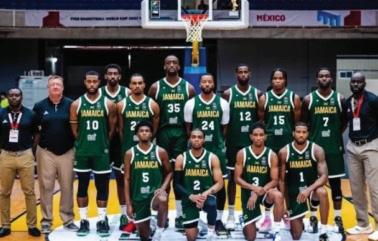

By Sean Devers
ON an enthralling opening day of the GISE, Star Party Rentals and Trophy Stall first division two-day Final at the Demerara Cricket Club (DCC) ground in Queenstown, Mavindra Dindyal scored 106 and shared in a 147-run fifth wicket stand before GCC lost their last five wickets for 13 runs to fall for 262.
Dindyal was last out for 106 from 146 balls with 11 fours and two sixes, while Renaldo Ail-Mohamed’s entertaining 87 lasted 73 balls and was decorated by eight fours and five sixes.
Rivaldo Phillips (28) and Navendra Persaud (14) were the other double-figure contributors.
Pacer Ezekiel Wilson captured 5-55 while Jonathan Van Lange supported with 3-38 for DCC, who ended the day on 198-4, trailing by 64 runs with six wickets in hand.
Guyana Captain Tevin Imlach was on 61 with six boundaries in an innings which lasted 103 balls. Guyana U-19 Skipper Van Lange is with him on 26 with three fours. The partnership has so far produced 37 runs. Raymond Perez made 71 in an innings which spanned 46 balls and included seven fours and two sixes.
When DCC began their reply, Thaddeus Lovell dismissed the left-handed Brandon Jaikaran for a duck at 14-1.
Yeudister Persaud trapped Joshua Persaud, who hit three fours in his 15, at 34-1.
Perez and Imlach joined forces and played enterprisingly with Perez reaching his fifty first. Pezez warmed up for next Sunday Inter County 50 overs final in Essequibo with an array of pugnacious shots on the tiny Queenstown venue before Kevin Sinclar removed him for 71 at 110-3 before Dindyal bowled

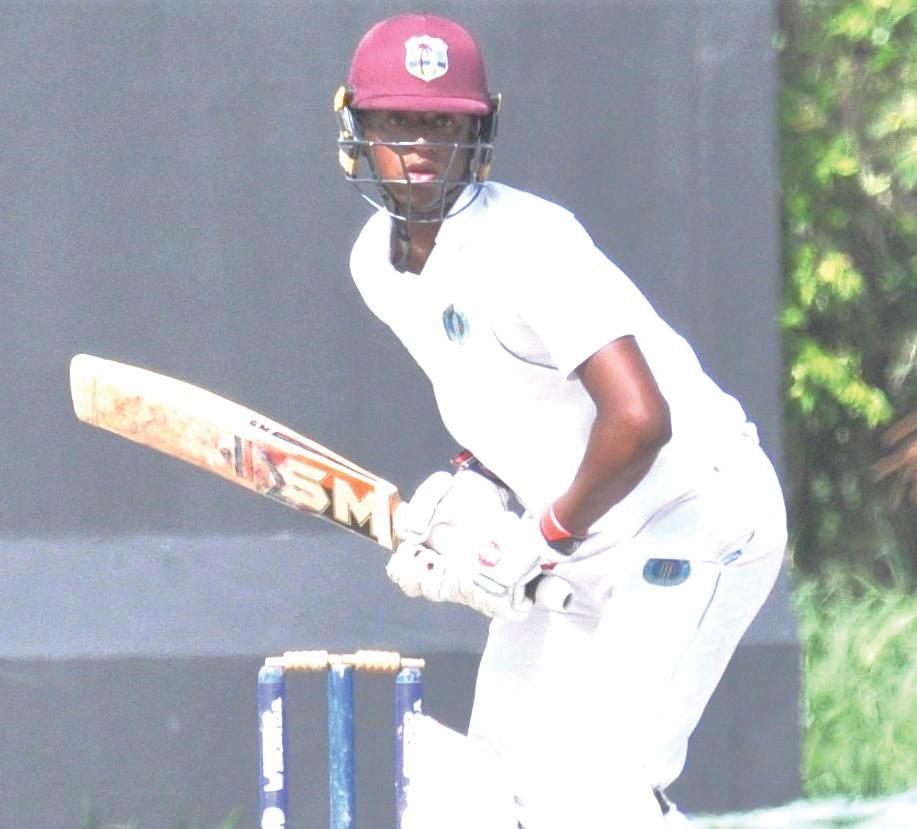
Sachin Singh (18) at 154-4.
Imlach soon reached his fifty as he and Van Lange (18) were together when stumps were drawn.
Earlier on a day blessed with bright sunshine, the home side invited the Boys from Bourda to bat on a track with some early assistance for the fast bowlers.
Watched by a small crowd, DCC reduced GCC to 39-2 inside 10 overs. Veteran Christopher Barnwell bowled Martin Pestano-Bell (4) to leave GCC on 17-1 in five overs.
Persaud hit a couple of fours in his 14 before he had his stumps disturbed by Wilson at 39-2 in the 10th over. The 50 was posted in the 15th over when Dindyal stroked the left-arm spinner Ashmead Nedd sweetly for a boundary.
With GCC on 51, Wilson removed stylish left-hander Akshaya Persaud (9) in the 16th over. West Indies batter Sinclair joined the elegant former West Indies U-19 right-handed Dindyal, and the pair added just four runs
on the small and fast outfield before Wilson again struck, dismissing Sinclair for one.
While Dindyal was content to play cautiously, Phillips was the aggressor, hitting the pumped-up Wilson for a six and a four.
Phillips, the brother of first-class player Ali-Mohamed, followed up his century in the two-day tournament with solid batting, and the composed Dindyall shared in a half-century partnership.
But with GCC on 106 and Philips on 28 he was lbw to Daniel Mootoo to bring his brother to the crease.
Ali-Mohamed deposited Mootoo for six and smashed him for four to post the 150 in the 36th over. By lunch, GCC were 153- 5.
After the Interval, Ali-Mohamed and Dindyal carried their fifth-wicket stand to 147 before Van Lange got rid of Ali-Mohamed at 253-6 to break the century partnership.
Ali-Mohamed’s demise triggered a dramatic collapse as GCC’s last five wickets fell for 13 runs. • Continues on Page 26
PORT OF SPAIN, Trinidad, (CMC) – The Trinidad and Tobago Cricket Board (TTCB) has started legal action against Alicia David-Jones, a former account executive, in relation to missing funds totaling close to $500,000.
Guardian Media Sport confirmed the legal action through a response to a Freedom of Information Act request from the Judiciary, dated August 12.
The action follows a promise by TTCB attorneys-at-law Henry Chase and Navinda Ramnanan back in June, to file civil proceedings against David-Jones to recover the alleged missing funds.
As first reported by the Trinidad Guardian in November 2023, a TTCB audit by former treasurer Kiswah Chaitoo, found that up to half a million dollars in funding was missing.
Chaitoo, a forensic accountant, reported in the AGM that he was unable to verify how $132,313 of TTCB funds up to July 31, 2023 – originally allocated for administration, cleaning, match fees, training and development, travelling, as well as office and general expenses – had been spent.
According to Chaitoo, further investigations revealed that more than $500,000 was unaccounted for.
Subsequently, David-Jones, who is being sued, wrote a resignation letter, admitting to taking some of the funds.
There is also an ongoing police investigation into the matter.
MIRPUR, Bangladesh, (CMC) – West Indies head coach, Daren Sammy has described his team’s performance in the just concluded ODI series against Bangladesh as “poor and disappointing.”
The regional side produced an abysmal performance in the third and final One Day International on Thursday, losing by a mammoth 179 runs to surrender the series 2-1. Their bowlers were scrappy, allowing the visitors to pile up 296 for eight in their 50 overs – the highest total of the three-match series – and in response they were bundled out for 117, with only Akeal Hosein, who batted at number nine, scoring more than 20.
Speaking in a post-match press conference, a visibly frustrated Sammy admitted that his troops underperformed in almost every aspect of the game.
“I’m really disappointed in the way we’ve
bowled. I mean look at the ODIs we’ve played this year [against] Ireland, England, even at home against Pakistan.
“You come in Bangladesh and spinners should be licking their lips, because that’s the area where you will get to execute your plans in the most favourable conditions for you, and what we displayed over the last three games have been very poor,” Sammy said.
“We’ve not been consistent enough, and all three games we’ve allowed Bangladesh to score above [average]. I thought it was more like a 3.5 runs an over pitch and every game we’ve had to score over four runs an over.
“And with the bat, again every time the challenge comes we lie down and die, except for when a Keacy Carty or Shai Hope put their hands up in challenging times.
“I’m very disappointed. Bangladesh played pretty well, kudos to them, but we
didn’t match them skill for skill with ball, bat or in the field, so they are deserving winners,” the head coach maintained.
Sammy said while the West Indies were not at their best in any of the three matches, he was particularly upset with the manner in which they approached the series decider.
He said even though the team had spoken about the importance of the match, their performances on the pitch left a lot to be desired.
“I think it’s a mindset. When we explained in the dressing room what this game means; you know we’re looking for automatic qualification, we have two teams fighting for the last spot before the cut off period and then you have a series decider on the line.
“Your mindset must be ‘I’m the one to do that’. You saw the mindset of the [Bangladesh] batters; they were like, ‘I’m going to be brave on that wicket, I’m going to set the
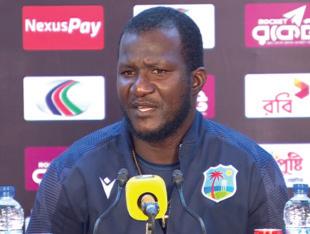
tone’ and the score didn’t reflect the wicket. The batsmen came in, decided to be brave in the Power Play and that put us under pressure and we took so long to answer…and we paid heavily for it,” Sammy said.